-
Posts
44 -
Joined
-
Last visited
-
Days Won
1
Content Type
Profiles
Forums
Events
Gallery
Store
Articles
Videos
News & Articles
Posts posted by Magda
-
-
On 4/5/2016 at 9:03 PM, Exhaustgases said:
So have you applied to be a tech at your local Lexus dealership? You have probably accomplished more than most of the auto techs could. If you want to improve your solder skills just get some old junk computer parts and experiment with them first. At the rate you are going soon you will be able to open your own repair shop, keep up the good work. And don't take such a long vacation from these lexus sites. You have done some very impressive things. Just remember there are lots of stories of people taking their cars to a shop and spending thousands and they never get it fixed. So you really have beat some of the shops out there with what you have done.
Thanks for your kind words and encouragement - I really needed it :) I haven't applied to be a tech yet ;) . I realize, many good people have to learn how to cut corners to make it in that industry, thus I would set myself for failure given I don't like to cut too many corners. I would be too slow doing everything according to bentley manual and triple checking protocols lol'
Indeed, I needed vacation from my Lexus - it was super frustrating to do first bigger set of repairs combined together just to face a very unfamiliar problem with no clear answer. I am pretty sure this repair would have cost me a lot at the local shop and it probably would have been rushed and not fixed properly. I have some horror stories with mechanics I carefully selected to service my cars in the past- unfortunately it's very difficult to find honest mechanics who do the job up to spec. I got fed up with being perceived as a girl who does not know about cars each and every time I went to service my car. Now I know about torque, wrenches, special tools and some car components and systems... If only I had discovered my mechanical capabilities sooner I would have had more fun maintaining my cars over the past.It's great to be a part of this community - you guys are awesome :)
I will try to fix LOW IDLE next which is kind of the opposite problem, but other than that my LS400 runs nicely given its mileage of little over 300 000 miles ;) -
Another revival of my thread.
First of all I would like to thank all of you for suggestions and great support!!!
I didn't do much with LS400 1990 of mine until recently. I guess I needed a Lexus detox after being unable to find a problem.
First thing I did was a SMOKE TEST:
I performed a smoke test with home made machine and it was a success!!!
Smoke test with homemade smoke machine - YouTube
Smoke test on LS400 1990 - YouTube
Looks like there are no major air /vacuum leaks - I was afraid that valve cover gaskets and plugs were installed with airleaks but they came out tight!
Two little leaks were present at IACV and its air hose which goes to air intake plastic black box.
Also some air was coming from EGR-VM vacuum modulator from its cap which may be normal as it vents air or sucks air through the filter - not sure...
Based on smoke test I decided to buy used IACV valve.
I tested new old IACV with multimeter for resistance - B1 to S1 or S3 and B2 to S2 and S4 which read around 23 Ohms and with 9v battery for function where I observed closing and opening. I installed it. The car started to run normal and smooth. But the rpms in idle are very low now, around 200 to 300 rpms.
My theory : IACV was stuck open and delivered air to the engine all the time causing ECU to add FUEL to maintain proper fuel to air ratio... This is why the rpms fluctuated, engine was running rich and car was trying to go faster by itself. There was too much air coming to the engine via stuck open idle control valve...
But now IDLE speed is really low: D or P idle is around 200 to 300 rpms... Way too low. Maybe I should adjust TPS?... But I tested TPS and it seems to be adjusted properly.
I've read through a lot of posts on this subject but i've hit a wall of sorts.
What if IACV is stuck closed now?... After all I installed a new old one .
It didn't stall yet but what if it does... It runs quiet.
It does not fluctuate anymore it accelerates nice and smooth. It runs smooth. Still needs some testing. I will drive LS400 for a while and see if ECM adjusts its settings and idle.
By the way, later I may get another IACV to see if it improves idle rpms, but at this point I'm happy with solving haunting / fluctuating idle!!! What a relief!
One day I may take ECM to see condition of capacitors but for now I just want to drive and not push my luck, given that my soldering skills are be that great lol
Thank you all for your invaluable input. I made friends along the way and learnt something about cars
-
 1
1
-
-
Keep up the good work. Your going to be the LS400 expert on this website.
So how did you reach the cold start injector? What seals it in the manifold? Did you have the intake off at all?
Try wiggling some of the wires and see if that affects anything.
Thanks :)
Cold Start Injector probably is not cleaned entirely as I did not remove it from the Air Intake Chamber. I cleaned the visible part of it when the Throttle Body was out for cleaning... That may be not a very thorough cleaning but better than nothing. It is shiny and clean on the outside lol
-
I did change the ECT
sensor and torqued it to 14 ft lbs for a new one. I had to buy 19mm deep socket from Craftsman (bought a set) as my cheap deep sockets were not deep enough in hexagonal crossection.
Attached are couple of pics from changing the ECT sensor.
However it did not change any behavior in fluctuating idle in Neutral and Park. Maybe my problem is a vacuum leak after all...
Once an old ECT sensor was out I checked resistance between two prongs of connector and when cold it was 2000 ohms when heated gently with a flame it dropped to 400. This suggests that old ECT sensor was probably good... But good to know
I also checked visually trunk hinge wires due to some suggestions. I took the insulation out and plastic pieces on the bent of it. All wires looked intact. Thus for now I will leave it without checking continuity on those wires destroying insulation. The second set of pics is for that trunk wiring harness..
Trunk Hinge Wiring harness before removing electric tape.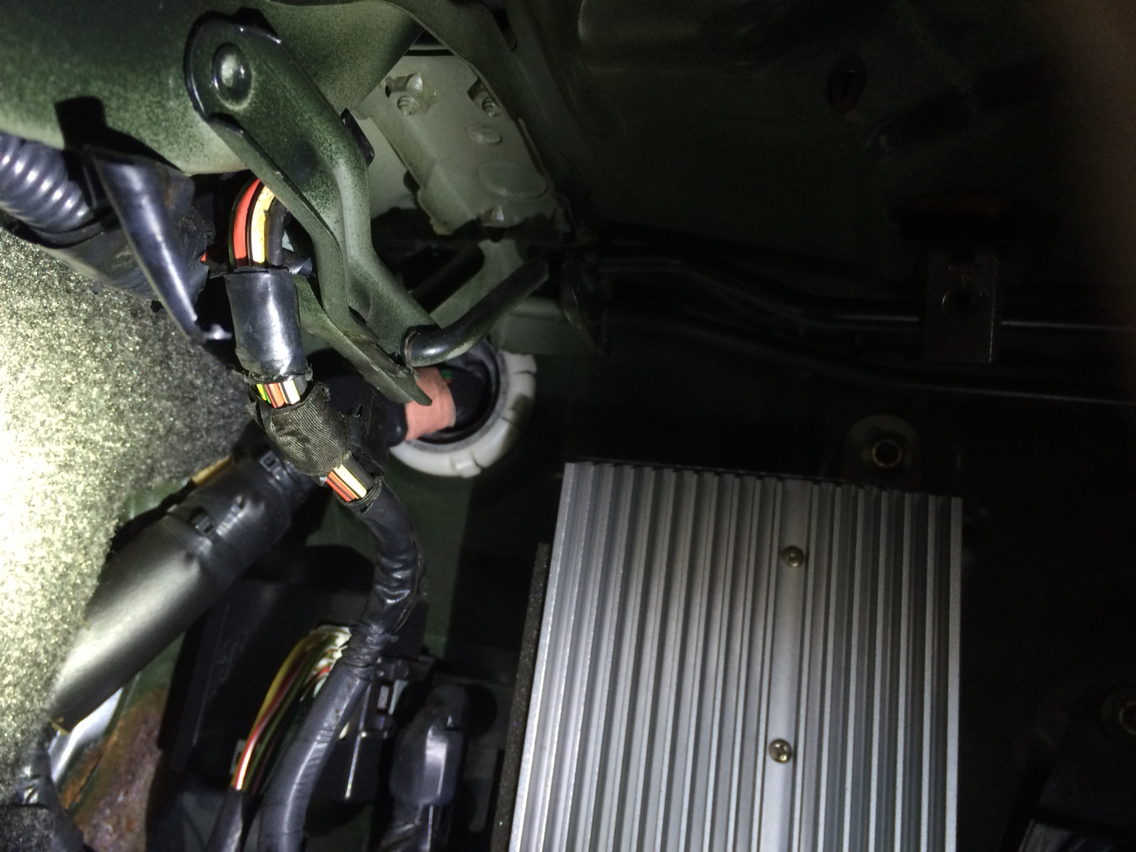
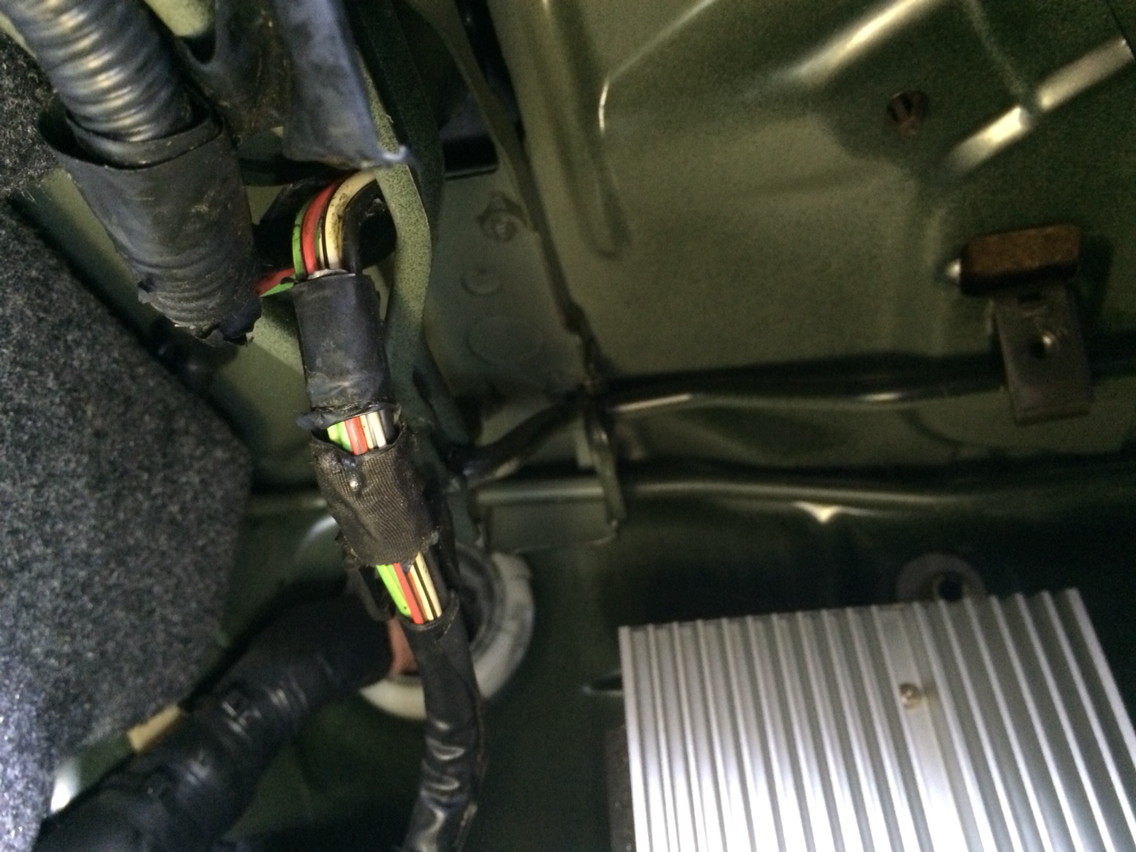
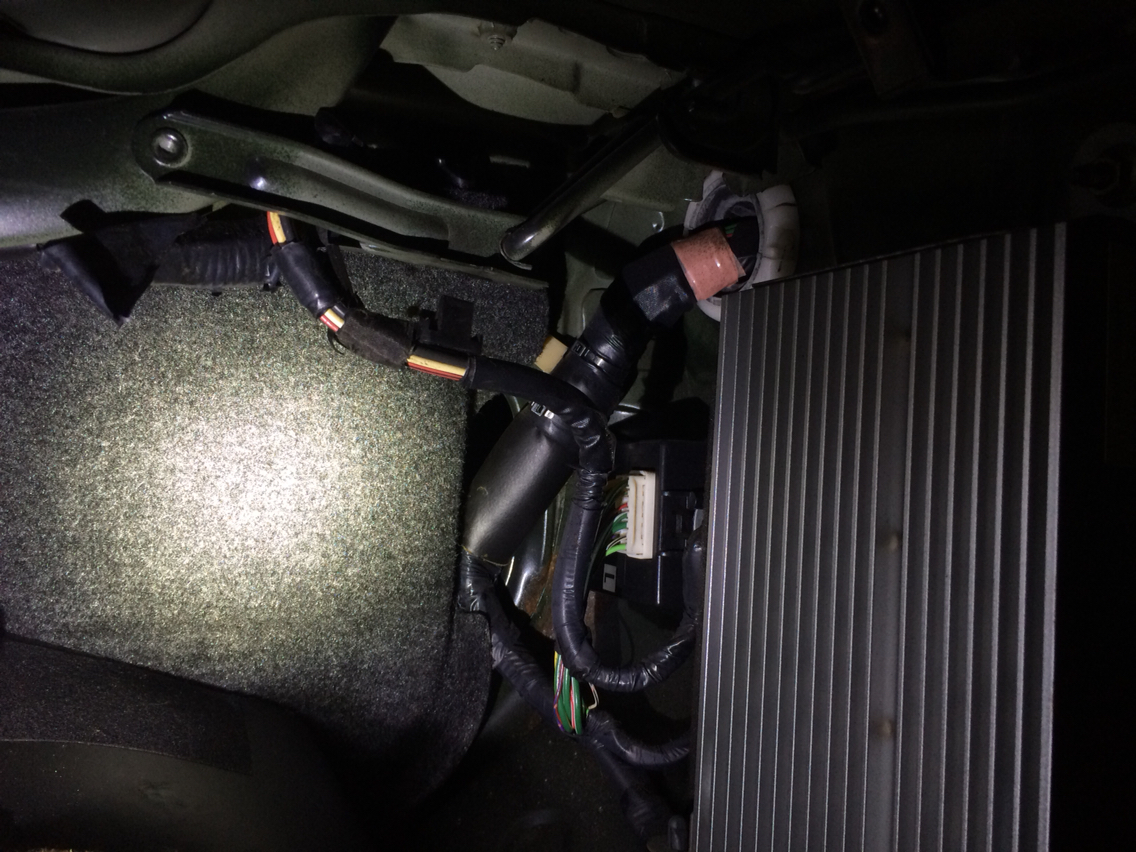
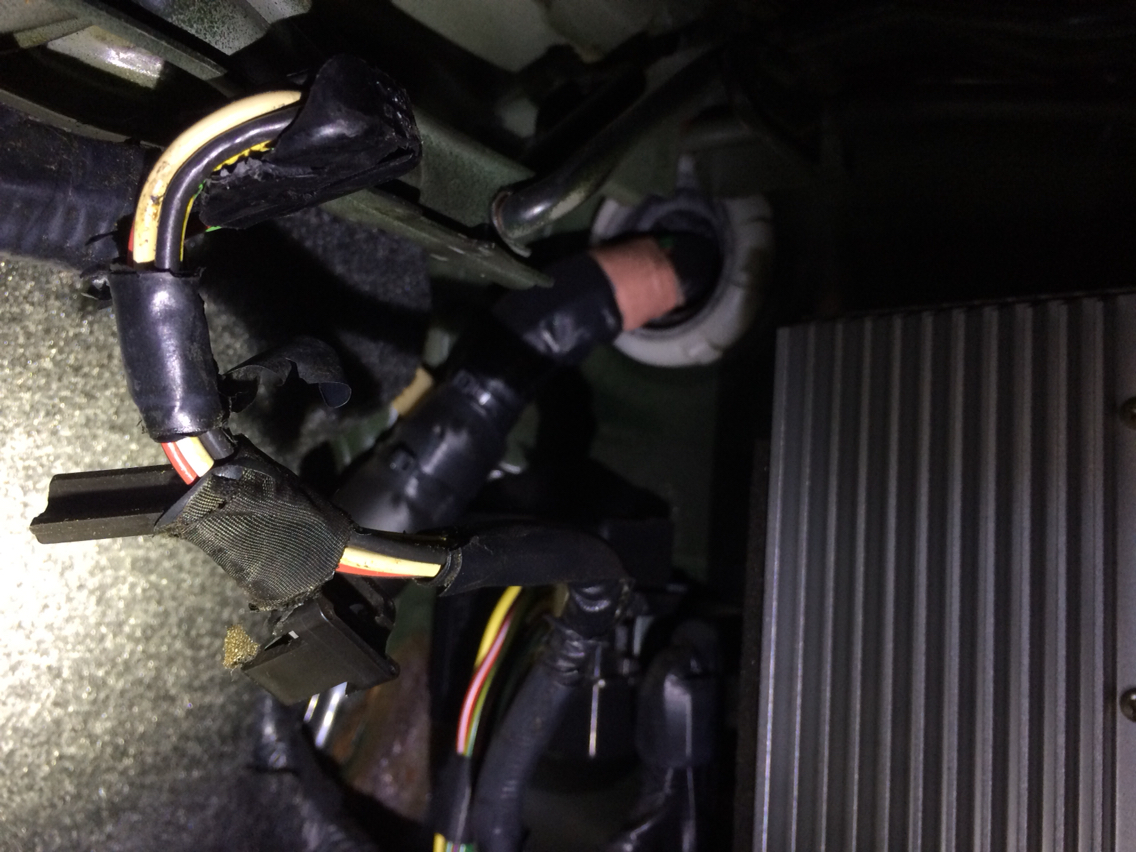
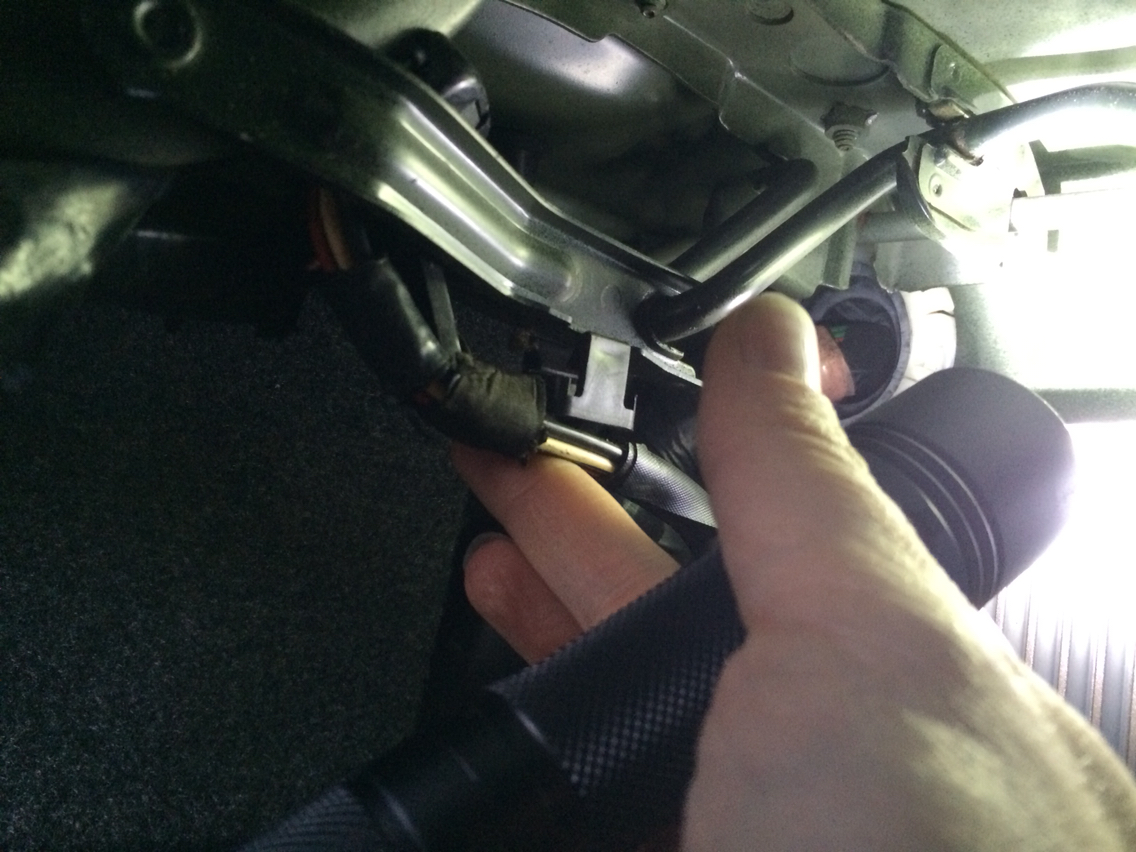
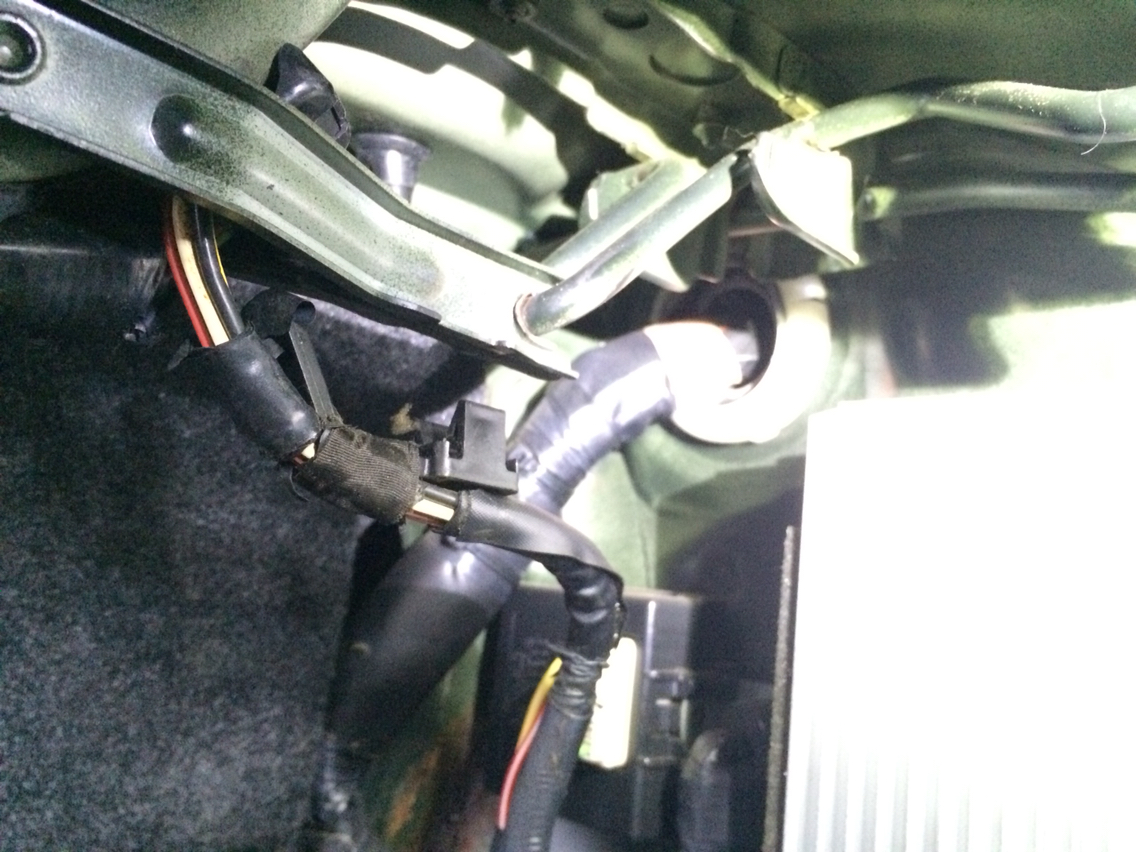
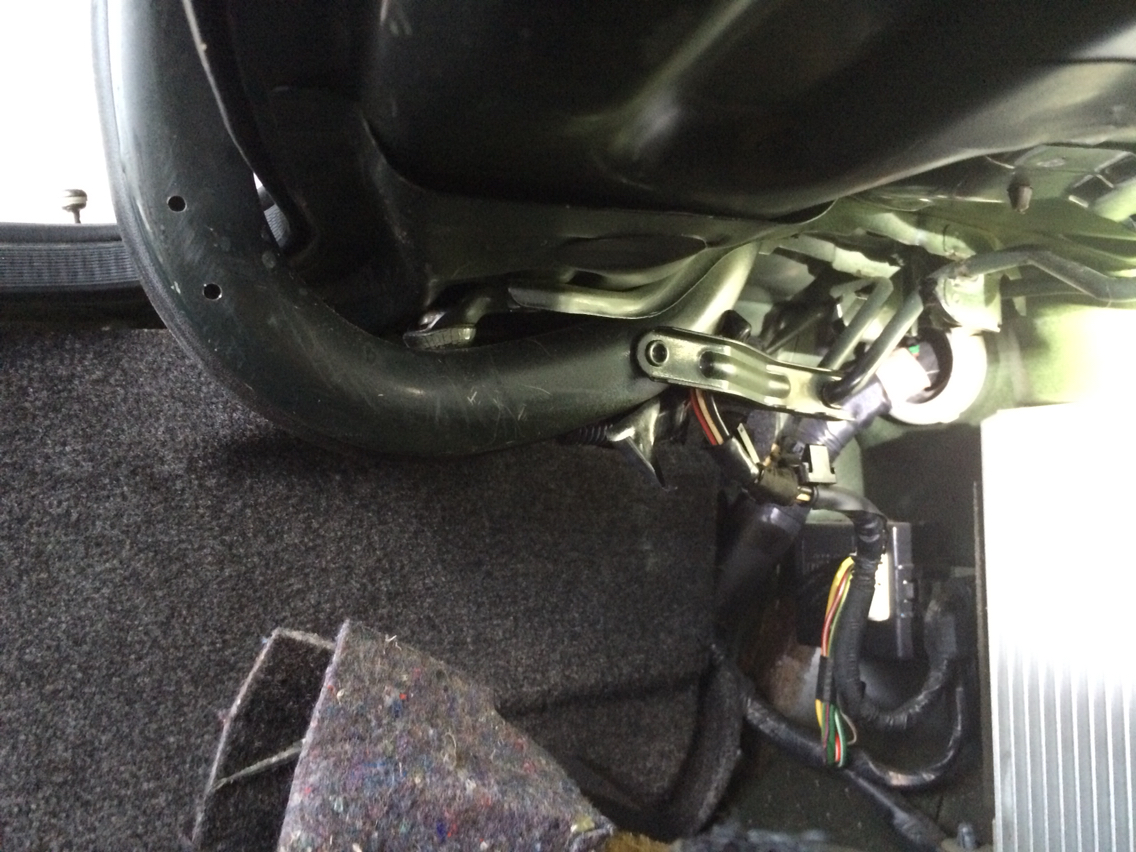
Trunk hinge Wiring harness after removing electric tape insulation. Pics
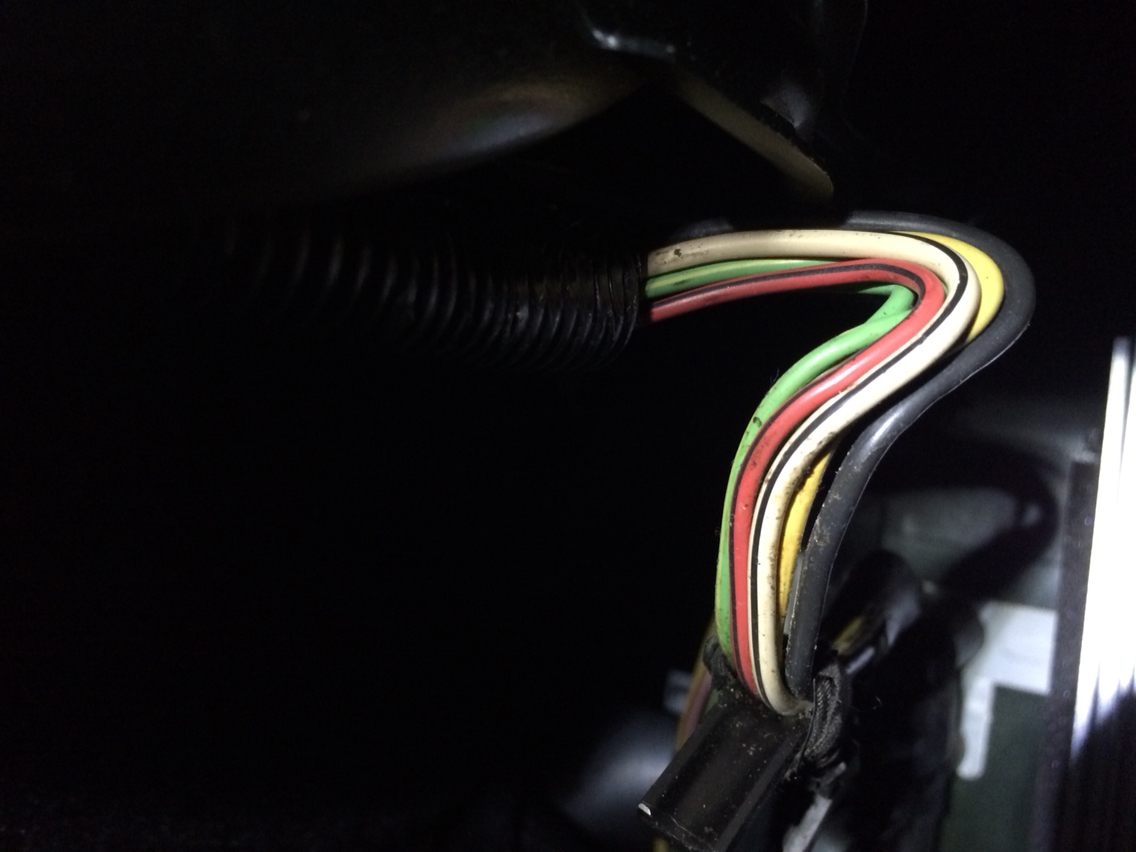
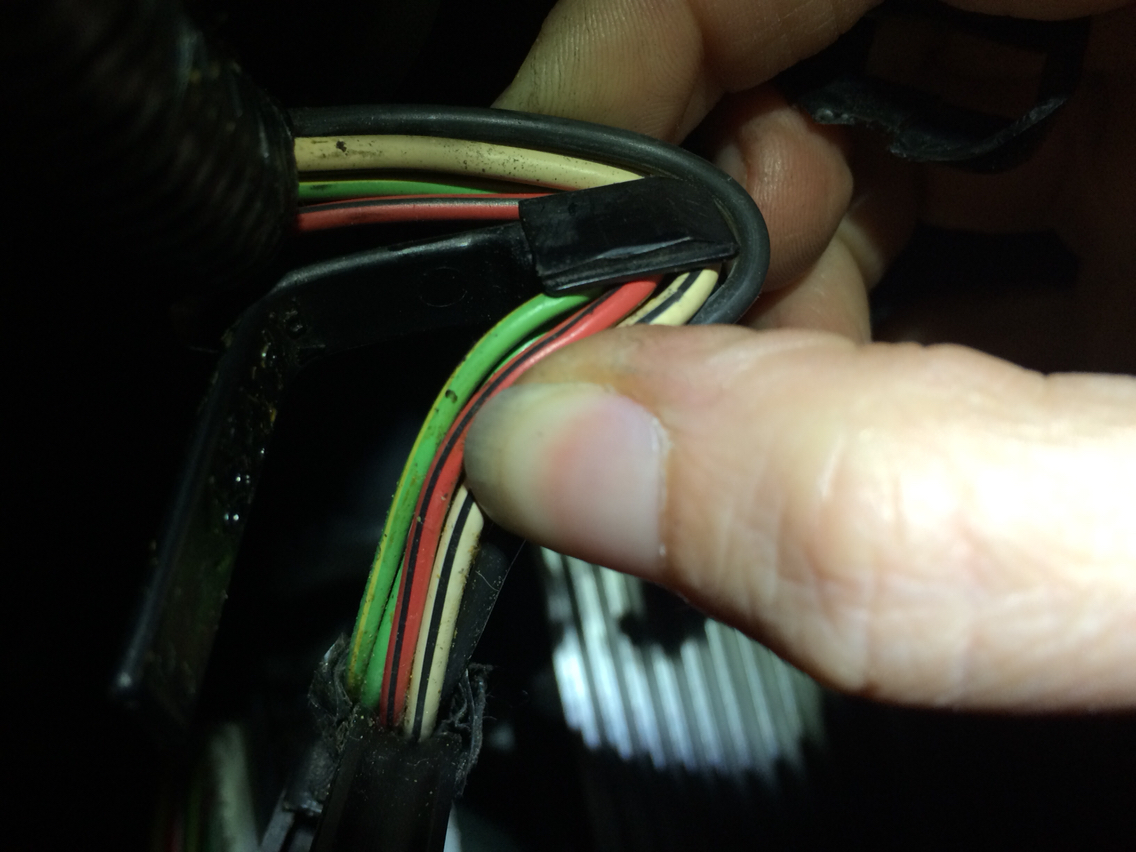
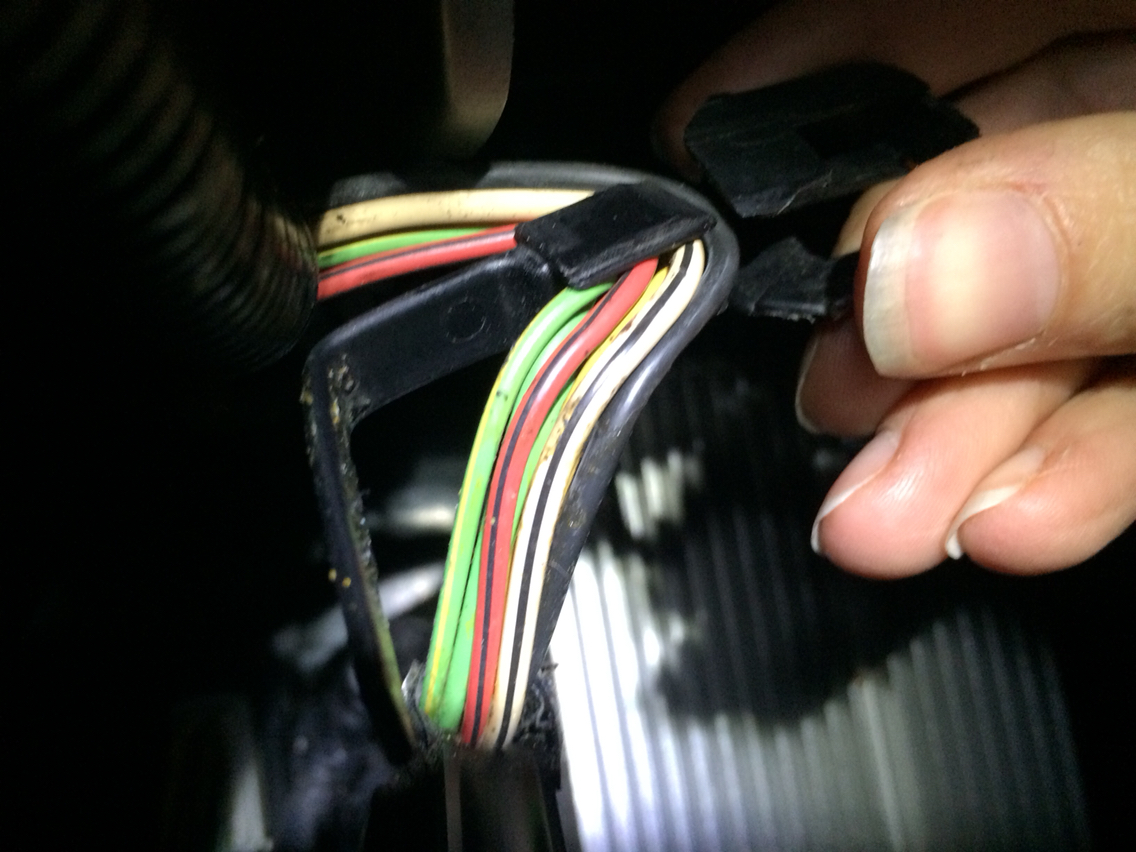
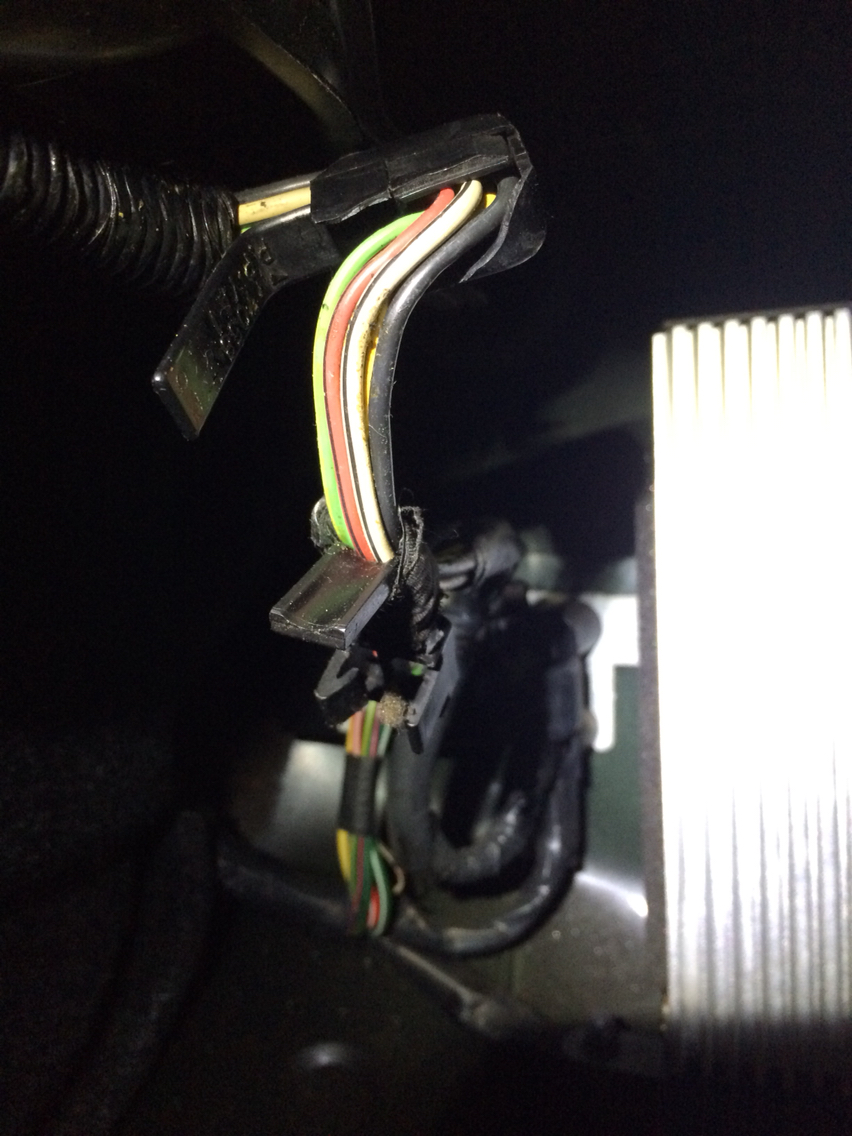
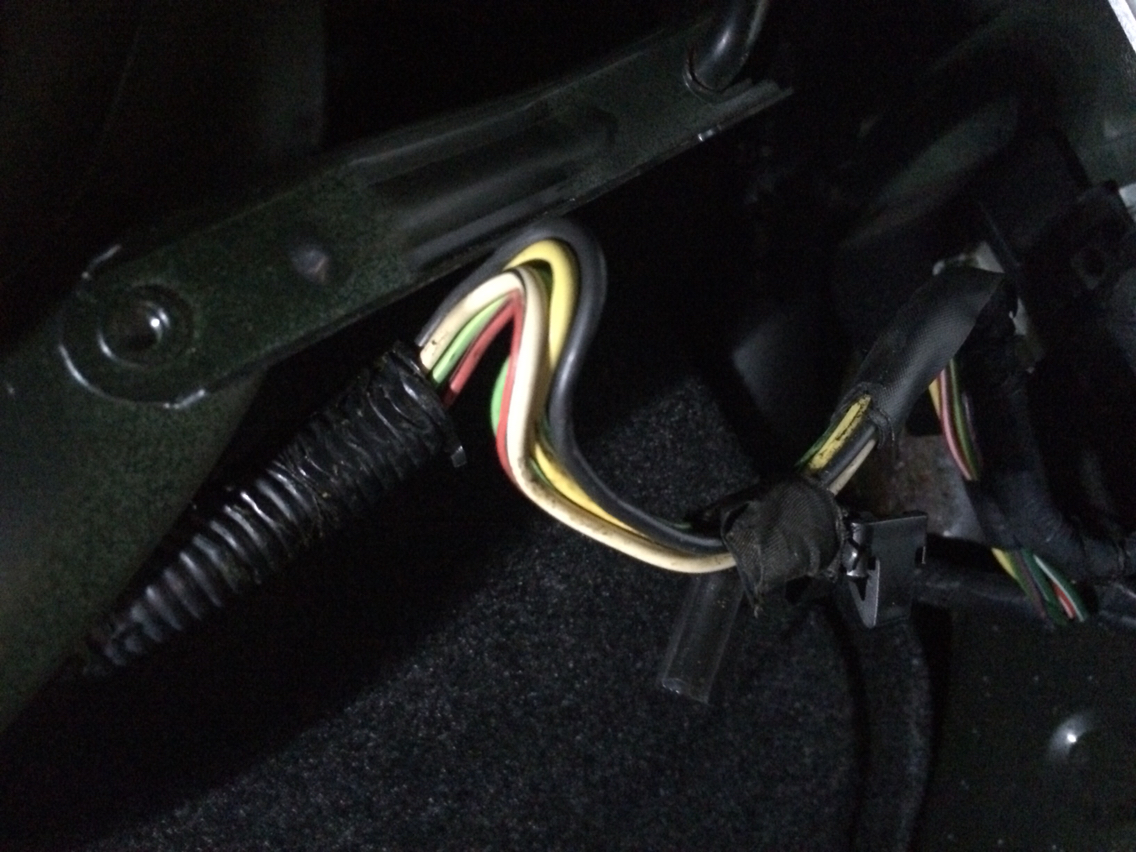
-
I tested voltage Vdc between OX1 and negative battery post as well as between OX2 and negative battery post while in P.
Below is the YouTube movies and excel sheet graphs I made based on movies. I wrote down the multimeter readings and correlated then with RPMs at subsequent time points. The engine was not very warm as you can see from the temperature dial of the dash. However my problem occurs at those conditions.
Observations presented here were made BEFORE changing ECT engine coolant temperature sensor.
Vdc OX1-negative terminal and RPMs (in this video I turned the car with cold engine after a few days in the garage so you can see how RPMs are gradually going up until the fluctuating idle begins):Graph:
The same was done for OX2:
Graph:
The values are approximate and sometimes it was difficult to catch all changes so keep it in mind

Also I assumed that .0L means 0mV !!!
I wonder what's going to happen once I install new sensor.
Happy Holidays to all of Lexus Fanatics
-
 1
1
-
-
Did you use the water bottle spray method to diagnose vacuum leaks?
Spray all intakes and hoses and any other possible leakage sites that come to mind.
That surging is almost always the IACV or a bad ECU.
The other thing that I modified in the past was the TPS , my car also had TRACS so it had dual sensors on the intake.
Lastly, cleaning the throttle body helped - all the Power Steering fluid sucked through a defective Power Steering Actuator valve had gummed up the throttle plates.
thanks for your suggestions.
I used propane to detect vacuum leaks. With no luck. Did not try water. Question: if it is from lets say manifold gasket, then how do i get to spray everywhere around it -its pretty inaccessible. Also i dont have smoke machine access.
I cleaned and tested IACV with multimeter... seems fine. I disconnected its connector and it did not remove the fluctuating idle symptom.
I replaced throttle body and sensors with Ebay-bought "new old" throttle body with sensors. Engine still fluctuates idle up and down...
Maybe it is bad ECU / ECU capacitors?...
-
This DOME fuse from second picture of post #45 that had 1.7 to 2mV was a result of my
MISTAKE: trunk was open during the test thus the light was on drawing
2mV... Once I closed the trunk it went down to 0mV...I updated the picture description accordingly...
To summarize:
I retested all fuses of MAIN JUNCTION BLOCK (including cartridge fuses) in engine bay - all had continuity and showed 0mV at Vdc. No blown fuses
observed.
I retested regular fuses of the DASH PANEL 0mV at Vdc and continuity was good. For some reason slot for RR.AC fuse was missing but
I am not sure if this fuse was supposed to be in my car.
Could not find at all 3 cartridge fuses of DASH PANEL that seem hidden: P/W, DEFOG, DOOR, thus they are not ruled out as potential culprits...The battery may just be bad and not hold charge... I may buy new battery and try to take closer look into Trunk hinge wiring harness.
-
And of course, you have checked your trunk hinge wiring harness already. Right?
I always had taillight bulb blowing problem... I am attempting to check the trunk hinge wiring harness right now... But did not trace them yet. Just looking at it. Looks ok. Nothing obvious. I unclipped the clip. Will try to trace the wires but am a bit hesitant as i don't want to cause the problem.
I updated post # 45 -additional info under second picture regarding *3 ALT fuse... I checked it. It tested fine - 0mV and continuity.
-
You know, Magda, the problem is not nearly as bad as it used to be. If you look at your post #8, the pulsing was much worse than it is now, 900 - 1600 vs 100 - 1200. So, it appears that you have had some effect with your cleaning. If you take it for a drive now, I will bet that it does not 'pull' as much as it used to.
I wonder how the engine runs if you pull the throttle body ducting off so that just the throttle body butterfly is exposed. It should run but maybe not real well. Might be an interesting experiment. I would be tempted to manually move the butterfly to see if it can fully closed and if it operates smoothly.
Dear Randall,
Thank you for your message :)
It indeed got gradually better. I was driving the car from time to time since summer, but was not in the mood to continue fixing it -needed a break ;) thus I did not post anything...
My LS400 once started increases slowly and gradually in rpms until it reaches approx 1200 then it starts to fluctuate between 800 and 1200rpms every second or so when in P or N... in a very regular fashion. In D, R, 2, L it keeps at 600 rpm when no gas pressed. It still pulls and I feel that when I'm slowing down to stop the gears downshift with noticeable jerking of the car...
Recently even before installing "new old" throttle body I was driving the car quite often and there were no codes... at least the Check Engine Light was not lit. It used to fluctuate between 1200 and 1600 rpm in P and N - thus it looks like it is slightly better now. It does not pull forward like it used to but it still will not require pressing gas pedal to slowly reach high speed... Also it is pretty bad in terms of fuel economy.
No noticeable difference was observed in this behavior after replacing Old Clean Throttle Body to Ebay-bought cleaned "new-old " Throttle Body which was done this past week... (both throttle bodies had original sensors attached which I did not touch/adjust in any way)
However, for a little while now I noticed that my BATTERY GOES DEAD nearly overnight - it probably went bad due to problems from the past. For a year or two I had occasional battery going dead, but never thought about it too much as it was occuring once in a while... maybe i got used to it, sometimes I left dome light on. I eventually went through car records... I realized that alternator was replaced twice in this car by my housemate, within 2 years timeframe -I think mechanics didn't diagnose the problem and replaced alternator because it was good money.
2011 September : Alternator replaced
2012 January : Battery replaced at PepBoys
2013 June : Alternator and L/F Oxygen Sensor Replaced
Back then I was not interested in car mechanics. Now the battery is 3 years old on its deathbed. I begin to think that maybe there is a parasitic draw which would explain why it goes dead so often. Or maybe the CAPACITORS on ECU cause strange problems -can they discharge battery like that?
SIDE INVESTIGATION of BATTERY PARASITIC DRAIN :
Today I checked Voltage and Continuity on most fuses, while the smart battery charger (NOCO GENIUS G26000) was connected to battery leads to make sure that my bad battery allows for voltage to flow to expose parasitic draw if any (I try not to make too many mistakes, but am new to electrical diagnostics).
I used EXTECH true RMS multimeter.
I did not pull any fuses during that test.
The battery was connected.
I let the circuits go to sleep - the readings were done at least 5 hours after parking the car in the garage.
The results were negative: All checked fuses had continuity and there was no measurable voltage (mV) present across fuses... I also checked cartridge fuses under the hood - the same results.
[Cartridge fuses were tested in situ as well, after gently popping the top cap off with small screw driver. Basically I just touched meter leads to both sides of it up top with the cap off.]
Below are some pictures and explanation:
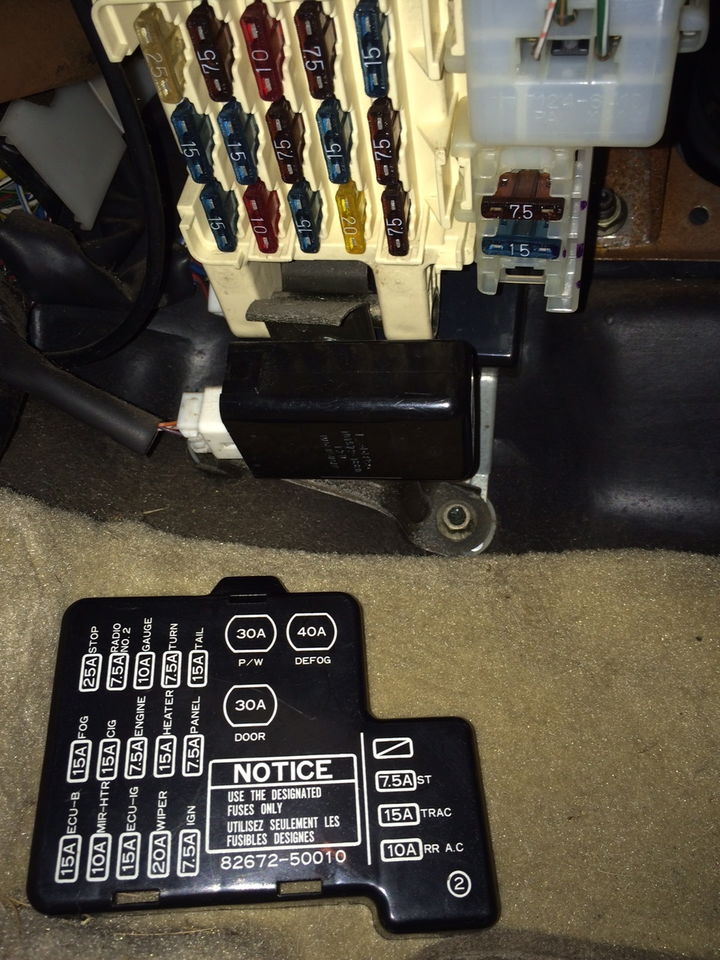
Kick panel / DASH FUSE PANEL fuses... All regular fuses showed 0mV and had continuity.
I could not access P/W, DEFOG nor DOOR cartridge fuses, thus I have not checked those... hope the power drain is not there. Not sure how to access them. Those 3 fuses described below:
* A P/W- 30 Amp: Preset Steering, Power Shoulder Anchor, Electric Moon Roof, Power Windows
* B DEFOG - 40 Amp: Rear Window Defogger
* C DOOR - 30 Amp : Theft Deterrent System, Seat Control System, Fuel Opener Control System
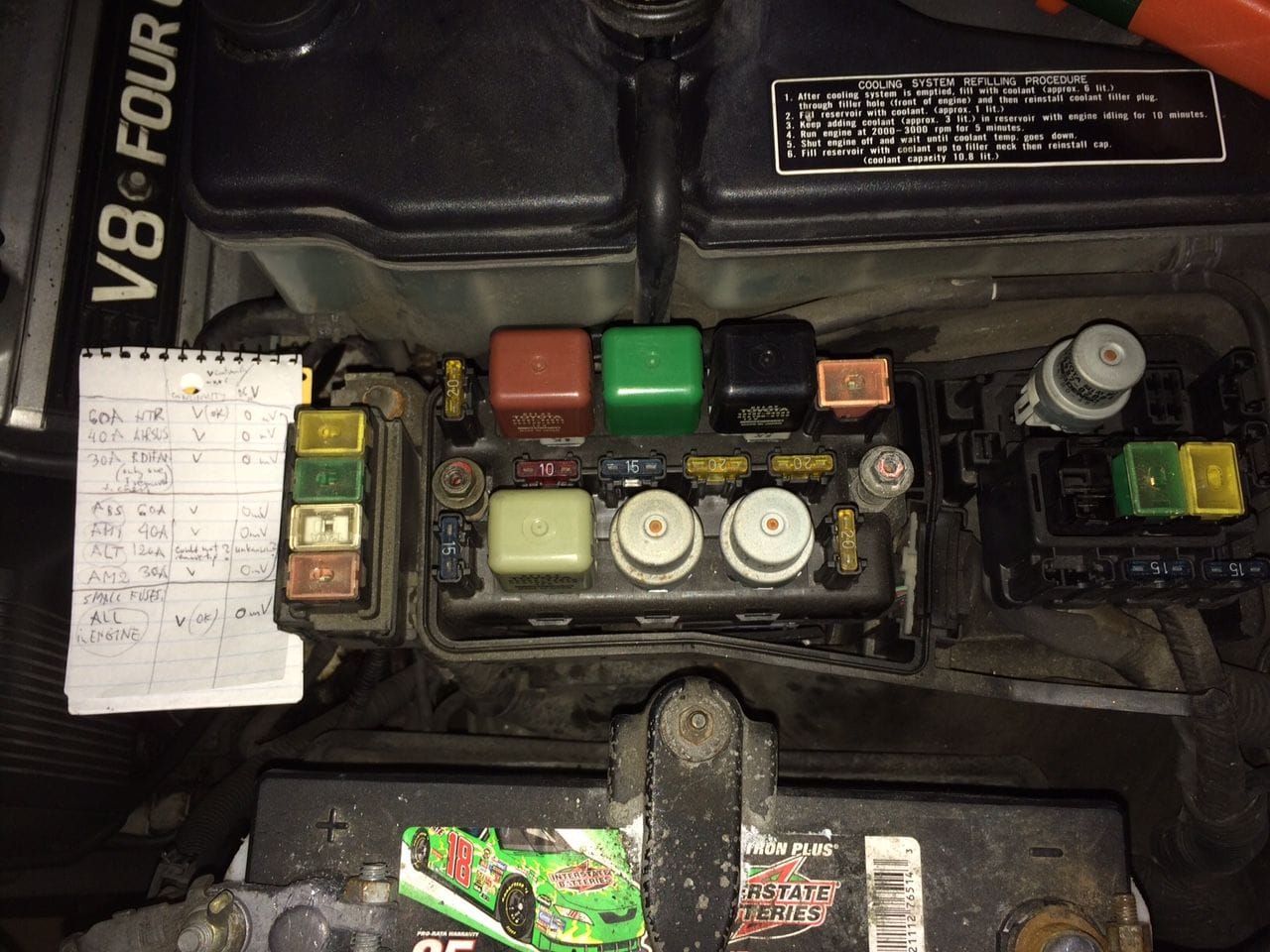
MAIN JUNCTION BLOCK / FUSES in ENGINE BAY.
I checked regular and cartridge fuses here. All checked fuses exhibited 0mV and good continuity.
The only fuse I did not check was cartridge fuse described as ALT 120A - I could not pop off the top...
*3 ALT - 120 Amp: Fog, Tail & Stoplights, Turn Signal Lights, Defogger & Seat Heater, A/C & Heater System, Power Shoulder Belt Anchorage, Door Lock Control, Power Windows & Power Seats, Antenna Motor, Cigarette Lighter, Combination Meter, Wiper & Washer
UPDATE 2015-Dec-11: I managed to pop gently the top of 3 ALT-120Amp Cartridge Fuse and checked it. It showed 0mV and continuity.
I also rechecked other fuses in Engine Bay/Main Junction Block -they again showed 0mV and continuity, apart from 7-DOME-10Amp fuse which had 2mV and continuity. I assume that 2mV is not enough to draw battery power.
RELAYS listed below I left alone:
* A - HEAD Headlight Control * B - ST Starter * C - ENGINE MAIN * D- MG CLT A/C Magnetic Clutch * E - HTR Heater Main * F - HORN* G - EFI Main
UPDATE 2012-12-12 12-12AM ;) :
This DOME fuse had 1.7 to 2mV, but it was the result of my MISTAKE: trunk was open during the test thus the light was on drawing
2mV... Once I closed the trunk it went down to 0mV...
To summarize:
I retested all fuses of MAIN JUNCTION BLOCK (including cartridge fuses) in engine bay - all had continuity and showed 0mV at Vdc. No blown fuses observed there.
I retested regular fuses of the DASH PANEL 0mV at Vdc and continuity was good. For some reason slot for RR.AC fuse was missing a fuse butI am not sure if it was supposed to be in my car.
Could not find at all 3 cartridge fuses of DASH PANEL that seem hidden: P/W, DEFOG, DOOR, thus they are not ruled out...
CONCLUSION: maybe my battery is just bad and does not hold charge...

schematic layout of Main Junction Block Fuse panel.

Measuring Voltage across Cartridge fuse.
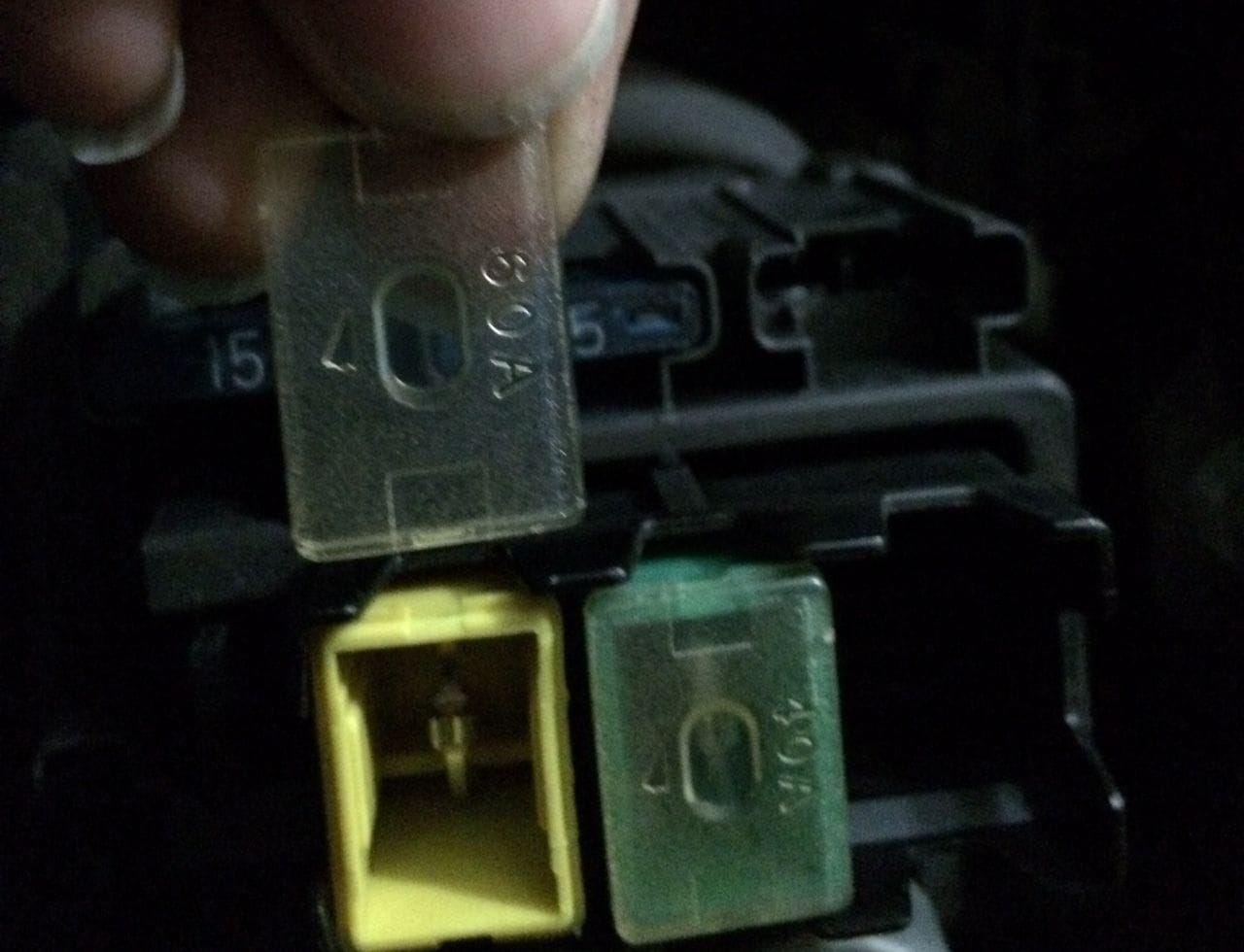
Popping off top cover from cartridge fuse in order to check voltage and continuity.
That's all for now...
I post long posts as it helps me keeping track of all those troubleshooting. I apologize if it sounds like rambling on :) . It is potentially all connected and significant.
Feel free to comment by including number of post you refer to as my quoted post may be too long to be seen twice or n-times in a row ;)
-
I wonder if its okay to unplug the IAC valve, to see if it does affect it. Does it do it when cold and hot?
That's a good point. A while ago I disconnected IACV /ISC valve CONNECTING WIRE to rule out that IACV/ISC is defective.
Then I turned the car on. The same behavior was observed.
The car idled with gradually increasing rpms from 1350 (when I started the engine) to 1500 rpms
which took approximately 40 seconds. Then It started to surge back and forth between 1100 and 1500 rpms in cycles...
It was a while ago when the rpms were reaching higher values.
Thus I concluded that neither the IACV valve (previous multimeter tests) nor its wire was the problem and there must be something else causing it... but what !
-
Fluctuating idle problem in lexus ls400 1990.
REVIVING this thread... Still wasn't able to track down the cause. But didn't do much since last post - I lost inspiration thus no posts for extended amount of time...
thus no posts for extended amount of time...
To remind you what was done just before problem appeared to be apparent:
- new Valve cover gaskets and rear plugs
- new spark plugs and new wires (tested wires resistance with multimeter)
- new distributors and new distributor caps
- cleaned egr pipe in air intake chamber
- cleaned cold start fuel injector in air intake chamber
- cleaned IAC valve
- removed and cleaned throttle body, put new TB gasket
After all that I started the car and the problem of fluctuating idle begun in N and P...
D, R, 2, L gears were at constant rpms when no gas pressed...
To troubleshoot:
-I checked vacuum lines, tried propane test with no luck.
-I rechecked IAC valve and tested with multimeter and all works within spec
-I used EGR blocking plate to rule out EGR valve. No change.
-I checked EGR with mityvac mv8000 vacuum pump. Within spec.
SINCE MY LAST POST I went for "vacation" from fixing my Lexus as it was upsetting that I could not figure it out...
-Recently I bought a new old THROTTLE BODY with new old TPS... I tested
it with multimeter and its within spec. After installation it didn't
help with the symptom. Thus I assume it was not TP nor TPS...
Currently after starting the car and keeping it in Park the rpms still
do the same thing... RPMs are at first rising slowly to 1200rpms then
start to fluctuate between 800 and 1200 rpm with rapid drop to 800 again
in the interval of time that stays pretty much constant...
It can be seen on my YouTube links below:Thanks for all your help and ideas :)
-
You sure that cam plug is sitting flush? What about the throttle body? Make sure the bolts are all torqued properly.
I'm pretty sure it is sitting flush...
-
If you spend the money on the tools you have something to show for the $.
That's true.
-
OK. I will keep slowly at it. Mechanics don't have time to troubleshoot - they check the codes and throw parts and labor at problems until they solve them costly ;). I probably would do the same if I had to make a living out of it... Below are notes helping me organize my strategy...
Idea 1: Maybe I can disconnect IACV and remove the part that I so nicely cleaned out, then cover the hole with something (need to figure out what to use as a plug) and then see if it normalizes rpms in any way, probably making it really high?. Probably stupid idea.
By the way, is there anything in lexus that acts similar to Fast Idle Control Valve from Honda, as I read that Hondas have a problem very similar to mine...Idea 2: find method to check Coolant Temperature Sensor... and make sure that my system does not have any bubbles... By the way, if it was the sensor or the bubbles, what would be the symptoms? and would they go away once the the engine got hot. Could any of it cause my symptoms?
Idea 3: adjust TPS with filler gauge and continuity to reduce the idle speed?...
Idea 4: adjust throttle body screw that is on dashpot, although I don't want to change it too much... (could that help in fluctuating idle?)
I'm rambling on a bit in order to get new ideas... I also want to evaluate all the ideas that I already got from all of you in order to get strategy that would allow me solve my problem with the least amount of trial and error lol . I cannot check everything at once... and each test requires me to study a new area of automotive knowledge and to buy new tools :( .
Idea 5: can i uncover throttle body inlet and then check what happens with IDLE? But what to do with the air hose from IACV and the little one connecting next to it that connect right after Air Flow Sensor...Would it be too much air for TB and intake chamber or too little? would it eliminate the function of IACV given the airhose from IACV connects right after air flow sensor? I apologize for possibility of wrong terms used here, as I don't know the names of all those parts...
Rambling on... hoping for the best... -
You seem to be real thorough with all your repairs. Sometimes those lil micro scratches can cause problems, that's why I asked. I'm somewhat stumped right now since your vouching for all the usual suspects. IACV, TPS, no leaks......
Craig, thanks for your response. I am not positive that IACV, TPS are 100% fine. I tested them with multimeter as described in this thread and both passed with flying colors. But i didn't test the connecting wires so I am not sure if all is fine... Also I tested for vacuum leaks, but it does not mean that I haven't missed one of those... I am puzzled and a bit tired, especially given that I am a newbie -I begun working on cars only last summer, mostly due to tight budget and partly because I like to fix things. My expertise in car fixing is not that great, but when I do something I try to educate myself extensively before even touching the problem / broken part. I may end up going to the mechanic, but am worried that he is going to just guess and throw parts at the problem, especially given that I'm just a girl...
-
I would be looking at the IAC and the throttle body cleanings. Those are the things that can change the idle the most unless yoyr timing is out of wack. Did you scrape the carbon build up with a screw driver out of the TB?
I did scrape the carbon build-up from the TB gently with a screwdriver and with a blade I also used paper towels soaked with TB cleaner spray. I was careful not to damage the TPS by exposure to the cleaner... After I reinstalled TB I checked with multimeter if readings are within spec and they all were, including filler gauges of proper thickness (see one of the previous post). I probably created some scratches with those tools but the alternative was to leave it dirty as the carbon buildup was so bad that cleaning just with towels soaked with TB cleaner did not remove the dirt but solidify it more... I may consider TPS adjustment... I haven't done it yet as everything was within the spec.
For IACV I didn't have to use the screw driver or a blade. Just rubbing with tissue soaked with TB cleaner was enough. It was a lot of work and it took a long time as I took my time to do a good job... Insides of the IACV were not really dirty, thus I did not clean it. But disassembling allowed me to inspect the valve for functioning and moving valve in and out allowed for better cleanup.
-
 1
1
-
-
Question E: By the way, I tested TPS but did not adjust it yet. Could TPS cause fluctuating idle in Park and Neutral?...
-
Hunting will be caused by the system trying to correct for something. Like too much air getting in and causing the idle to go up. Then the ecu says no, your supposed to be idling at this speed and corrects it.
With out a good way to check the various signals its going to be a hit and miss deal. When its cold does it do this or just when it warms up.
It does it when it's warm. It starts doing it approximately 1 to 1.5 minutes after turning cold engine on(cold after New York hot summer night...), but after 1 to 2 minutes of idling I don't think that the engine is fully warmed up..
-
Hi,
Thanks for all the advice so far...
I recently was busy with my other stuff, thus not too much car work to show for... I am a bit afraid to drive it due to the fact that it kind of goes to 45mph without hitting gas pedal --> don't want to ruin brakes.
Just wanted to rule out simple things first... Also given my very limited mechanical experience, it is a learning experience thus be patient with me. Sometimes I need to read a lot before I do something.
Since my last post I did some simple tests:
1. replaced PCV valve --> no change
2. Checked if EGR valve itself responds to applied vacuum --> I connected vacuum pump to its top vacuum connection and applied vacuum.
The valve opened and held vacuum, thus it looks like valve can be opened and closed by vacuum. See pictures below: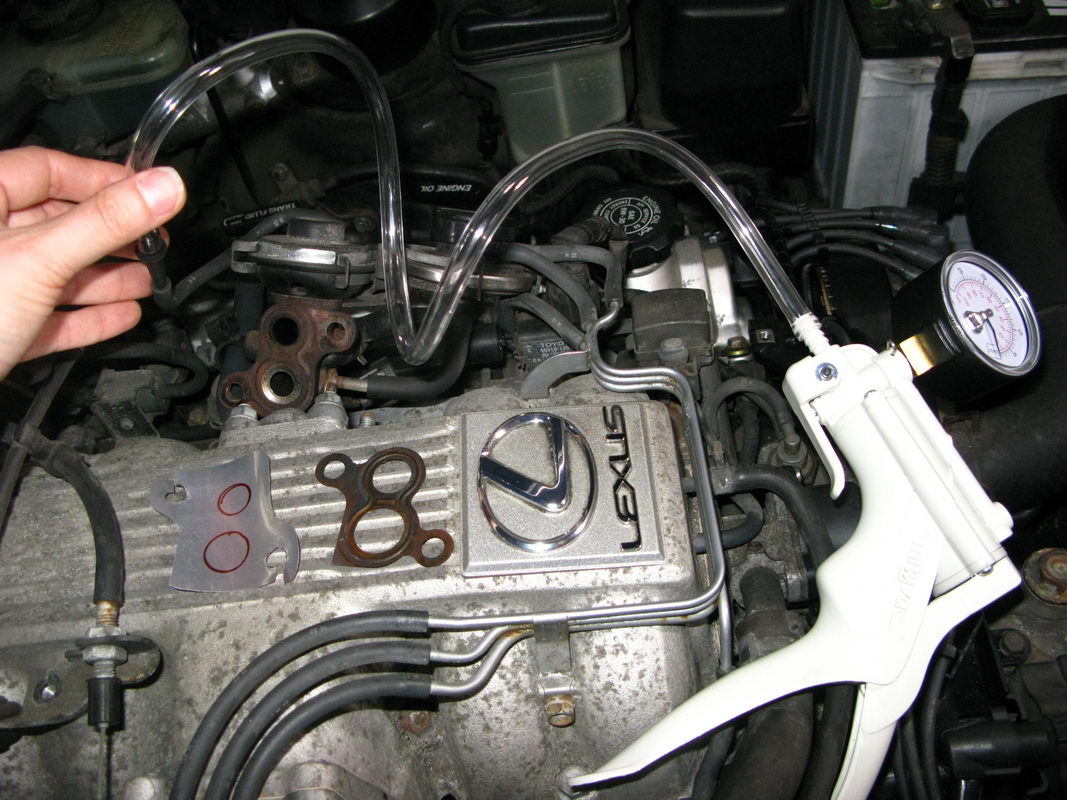
I made blocking plate from Coke can foil that i installed instead of
regular metal seal, to rule out that the EGR valve stays stuck open.
Blocking EGR didn't remove the fluctuating idle phenomenon, thus it
looks like EGR is not the cause of it.
I made blocking plate from Coke can foil to rule out that the EGR valve stays stuck open.
I tested EGR valve when the car was off. Here no vacuum applied and the valve is closed.
I tested EGR valve when the car was off. Here when I applied vacuum to EGR valve the valve opened thus it works.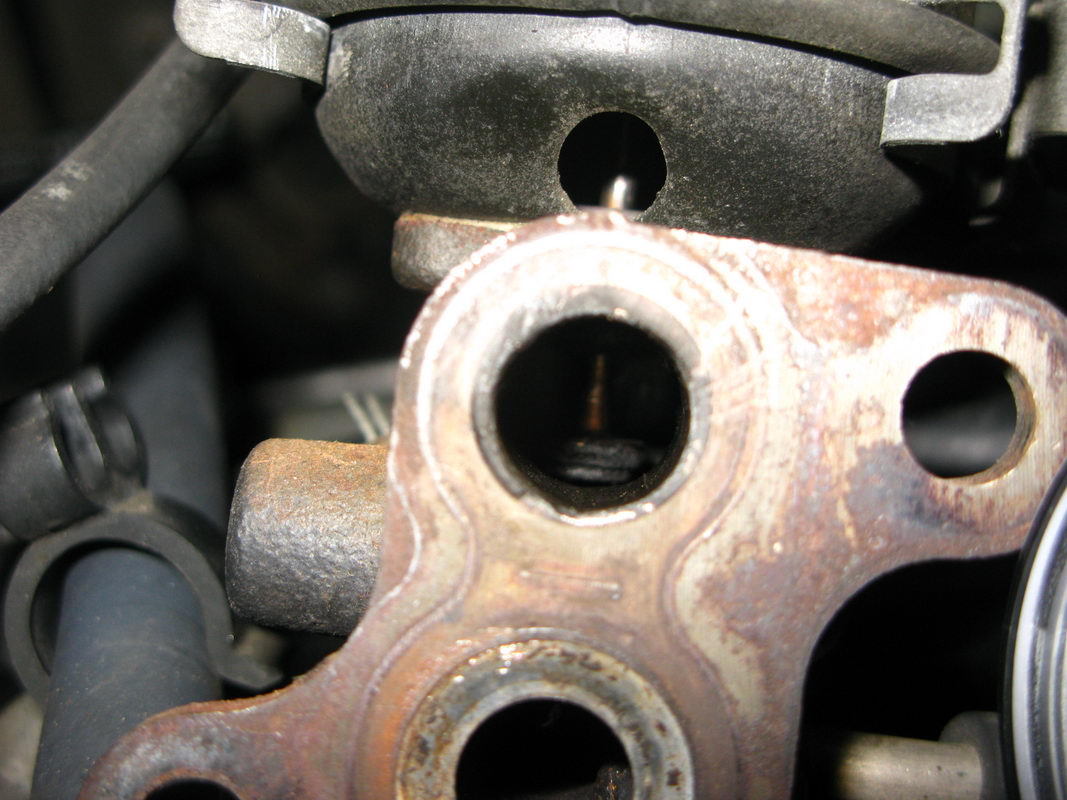
Opened EGR valve when the vacuum applied is shown in this picture.
3. I looked carefully on vacuum lines and didn't find any obvious vacuum leak.
4. I disconnected battery a few times and each time it relearns, it ends up fluctuating in Neutral or Park after 1 to 2 minutes. When the car is already wormed up it starts fluctuating nearly immediately once I turn the car on. It now fluctuates between 950 and 1300rpm in Park. I may decide to take it for a drive, but am a bit affraid about the car going too fast as brakes on 1st Gen LS400 are relatively small.
UPDATE WITH PICTURES FROM THE MOST RECENT WORK FROM BEFORE THIS THREAD:
Air Intake Chamber during cleaning from carbon deposits.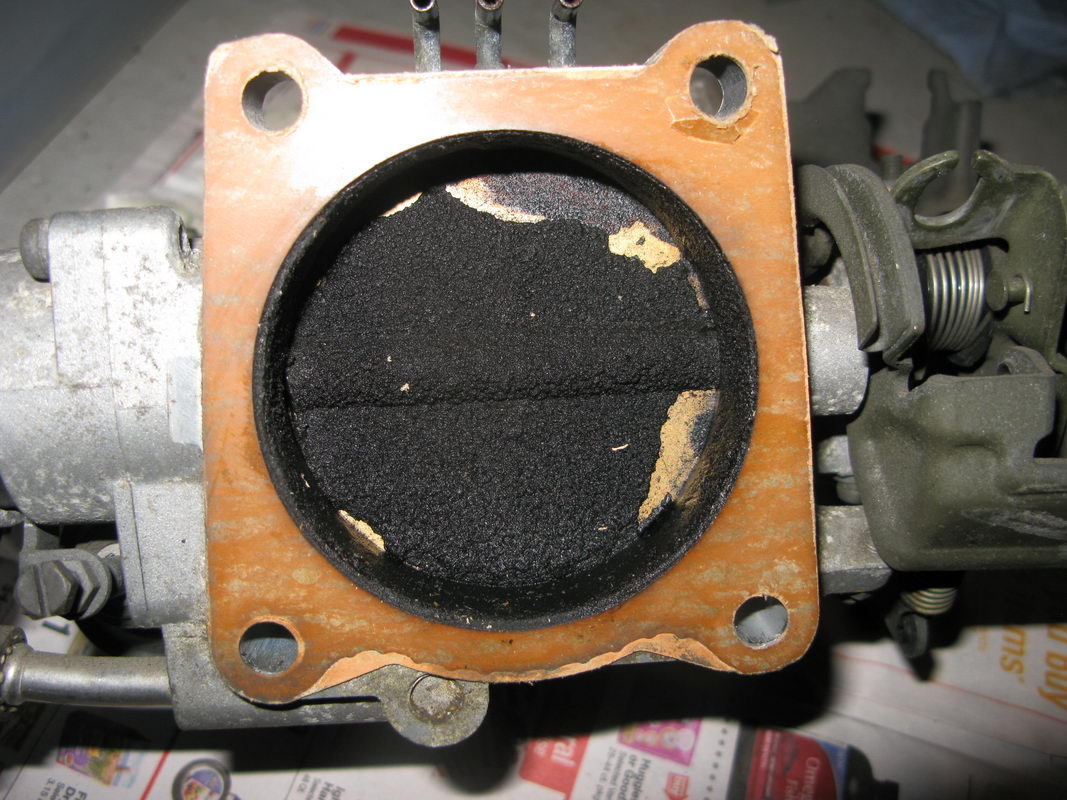
Throttle body (TB) was a nightmare to clean.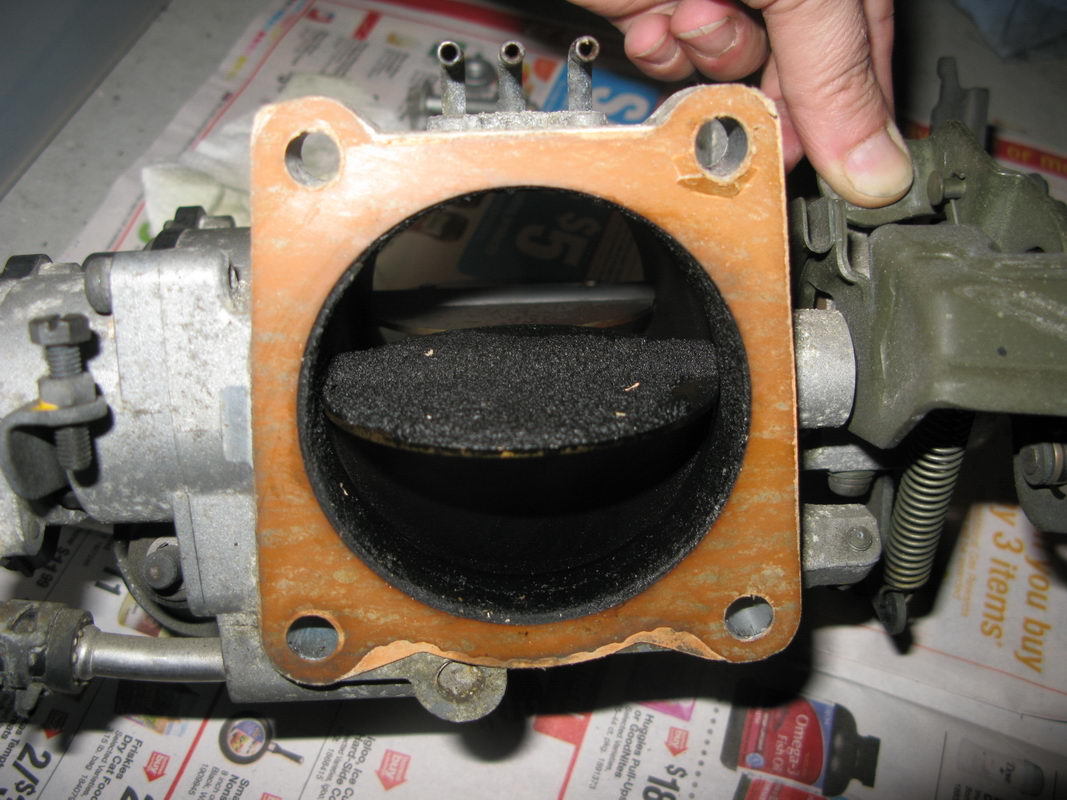
It was very dirty... I cleaned it scraping it before I used TB
cleaner. If you use TB cleaner first, the dirt just sticks to the metal
better...
EXCAVATION PROJECT: Air Intake Chamber during cleaning from carbon
deposits. EGR little pipe was completely clogged!!! I thought it was
solid metal rod at first... not a pipe.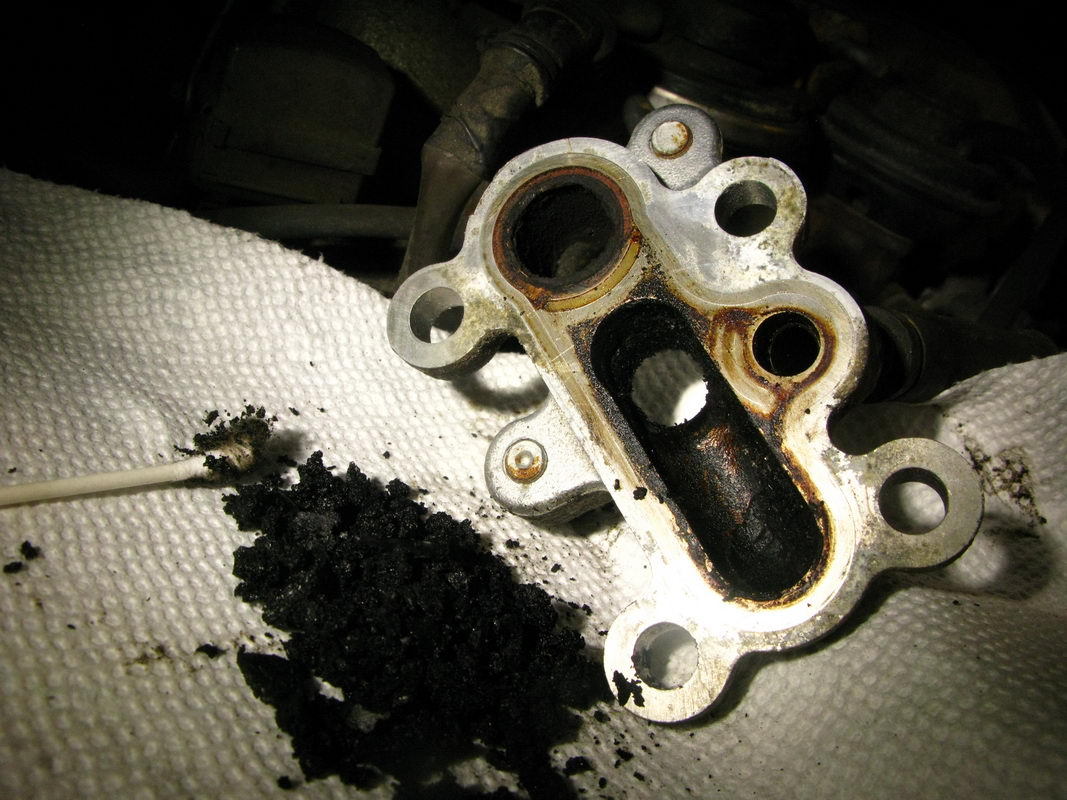
EXCAVATION PROJECT: EGR/PCV inlet housing (not sure its name) was totally filled with carbon deposits,
EGR little pipe and Cold Start Injector after cleaning. Not 100%
clean, but it was very difficult to get to this point. I put towels in
to make sure dirt does not go into the engine...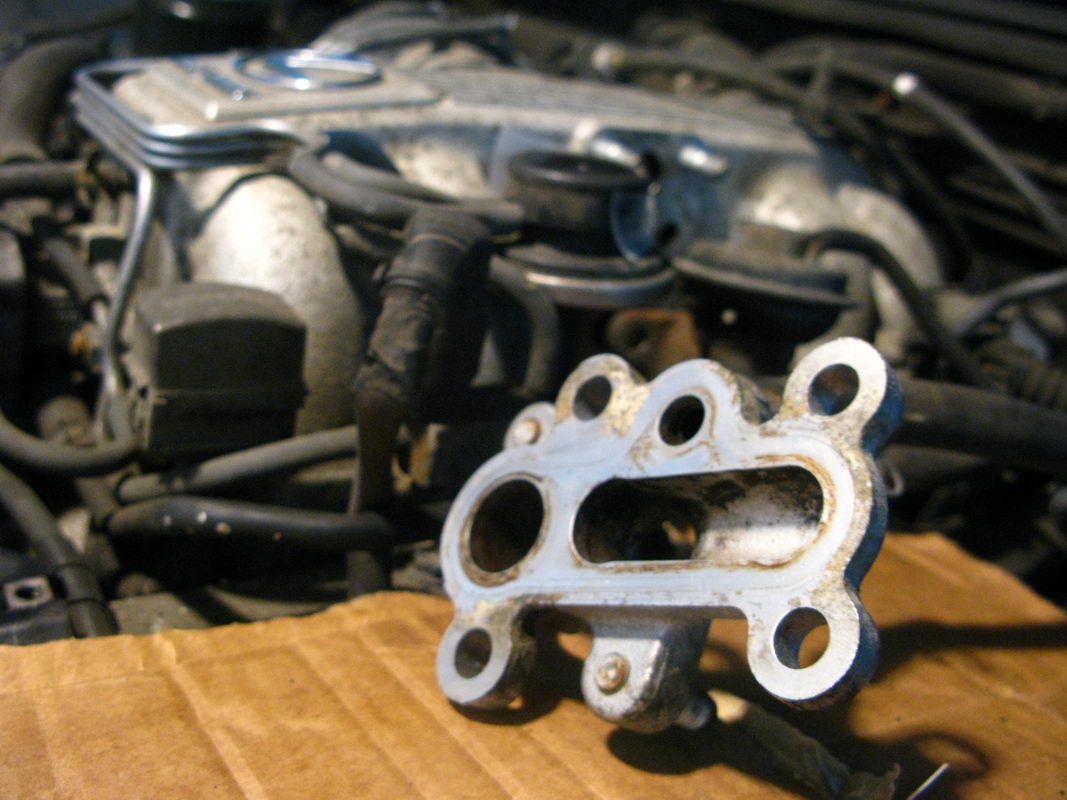
clean at least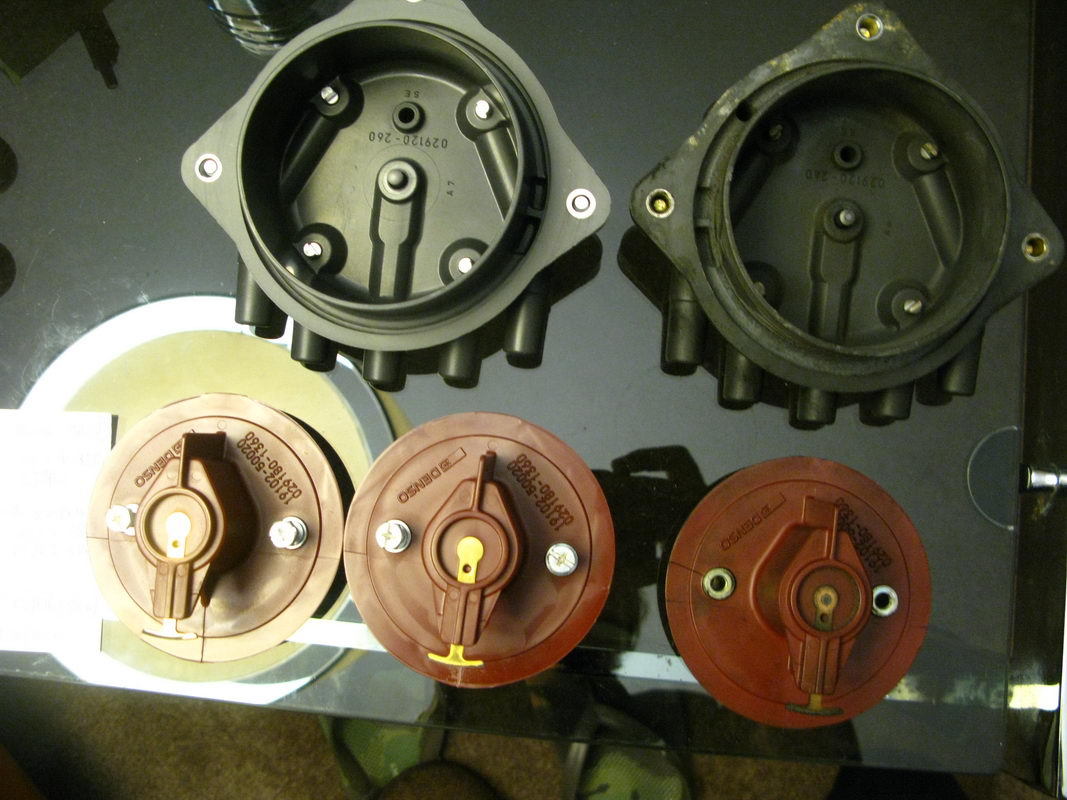
Distributor cap and rotor new (left) vs old(right)
Distributor cap and rotor new (left) vs old(right)
Old had cracks in plastic next to metal T-shaped part, which are visible in this pic.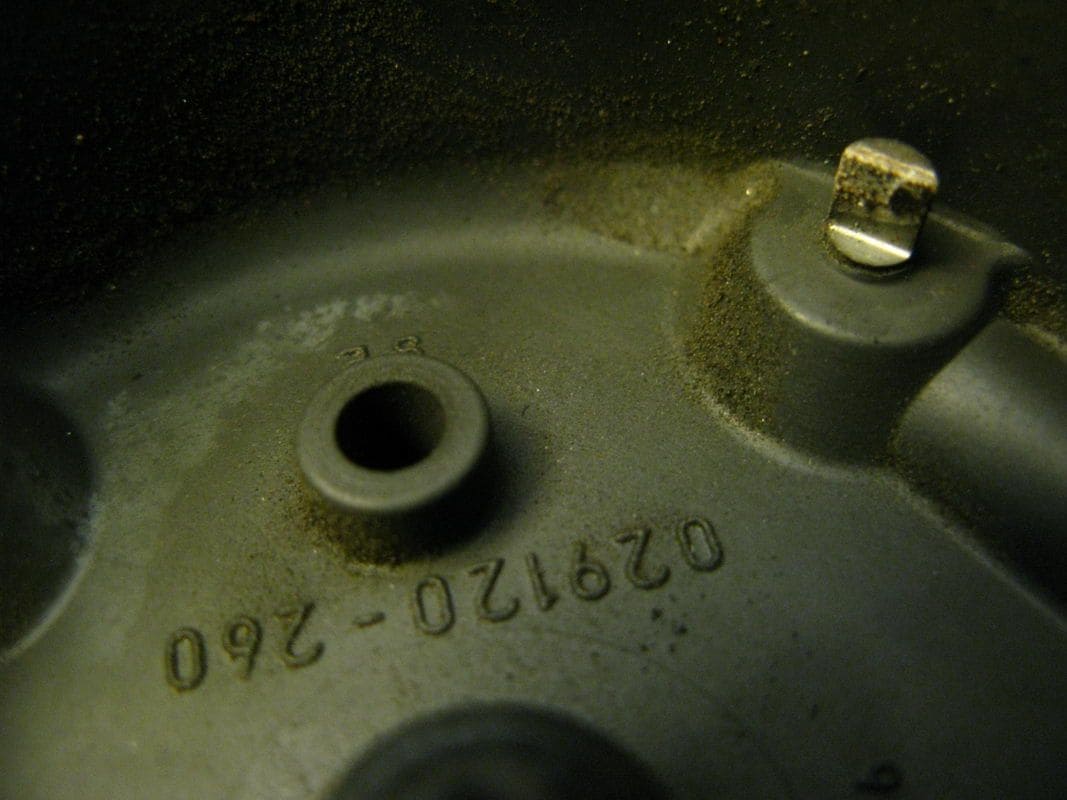
Old distributor cap.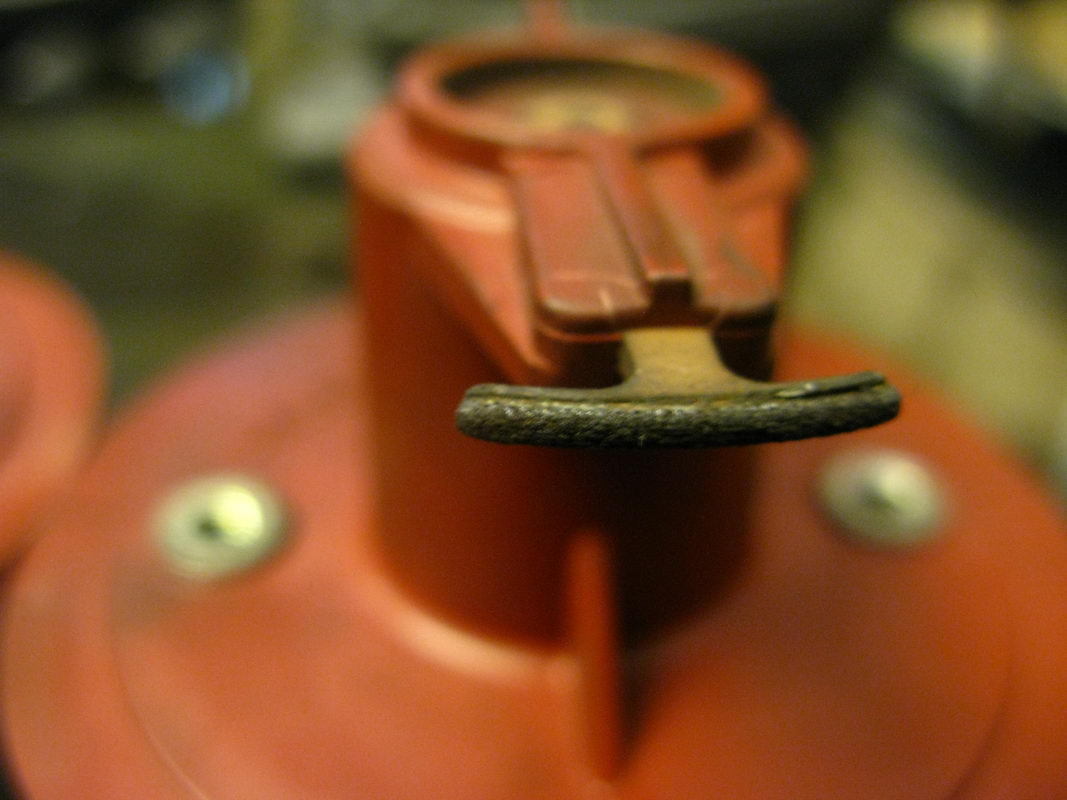
Visible cracks in plastic.
New rotor.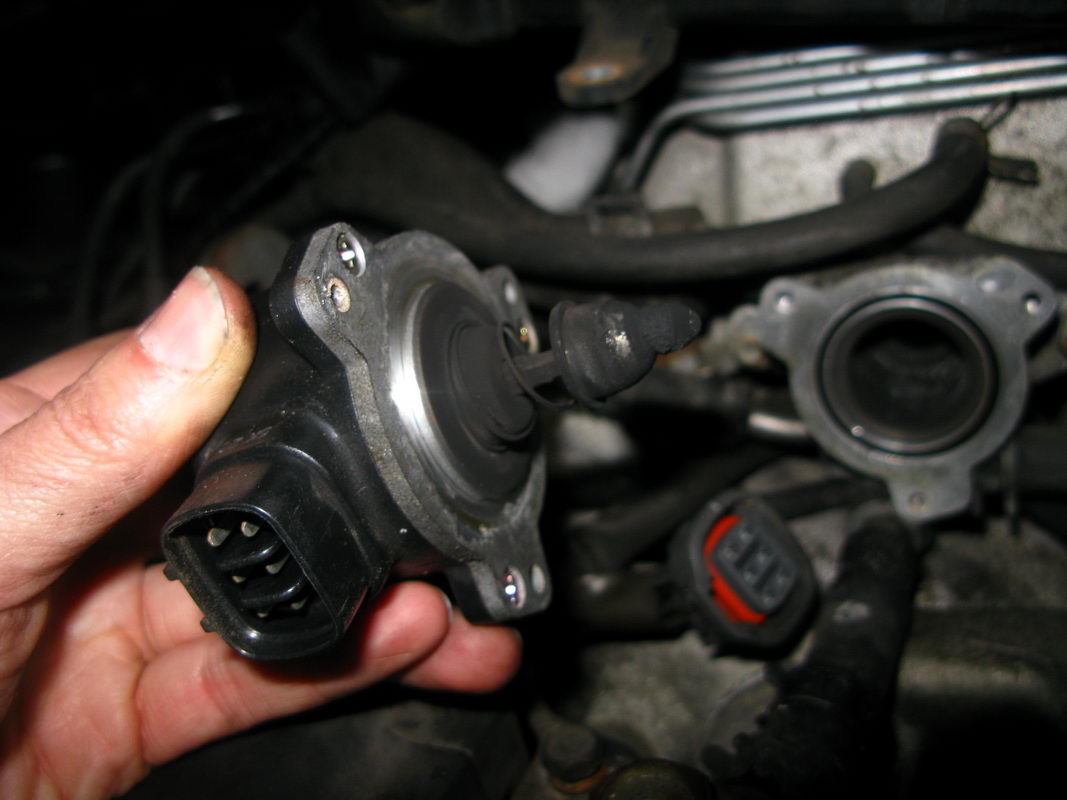
I also cleaned IAC (Idle Air Control) valve, because as you can see it was dirty.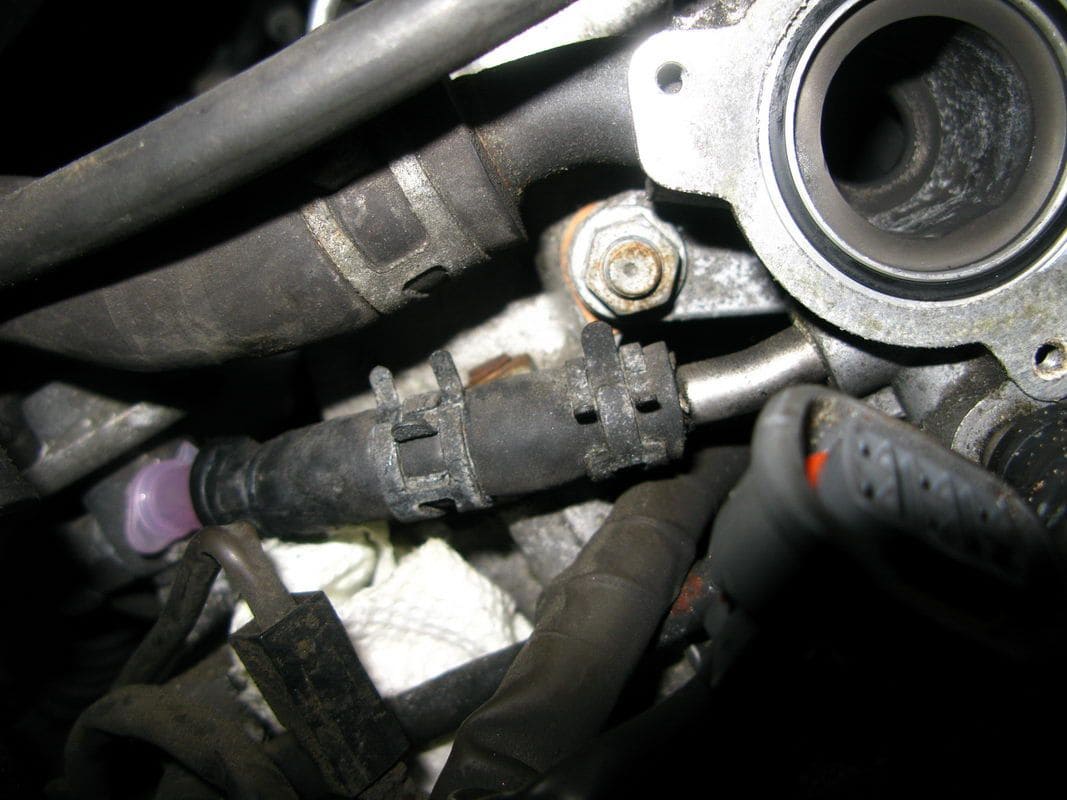
IAC passage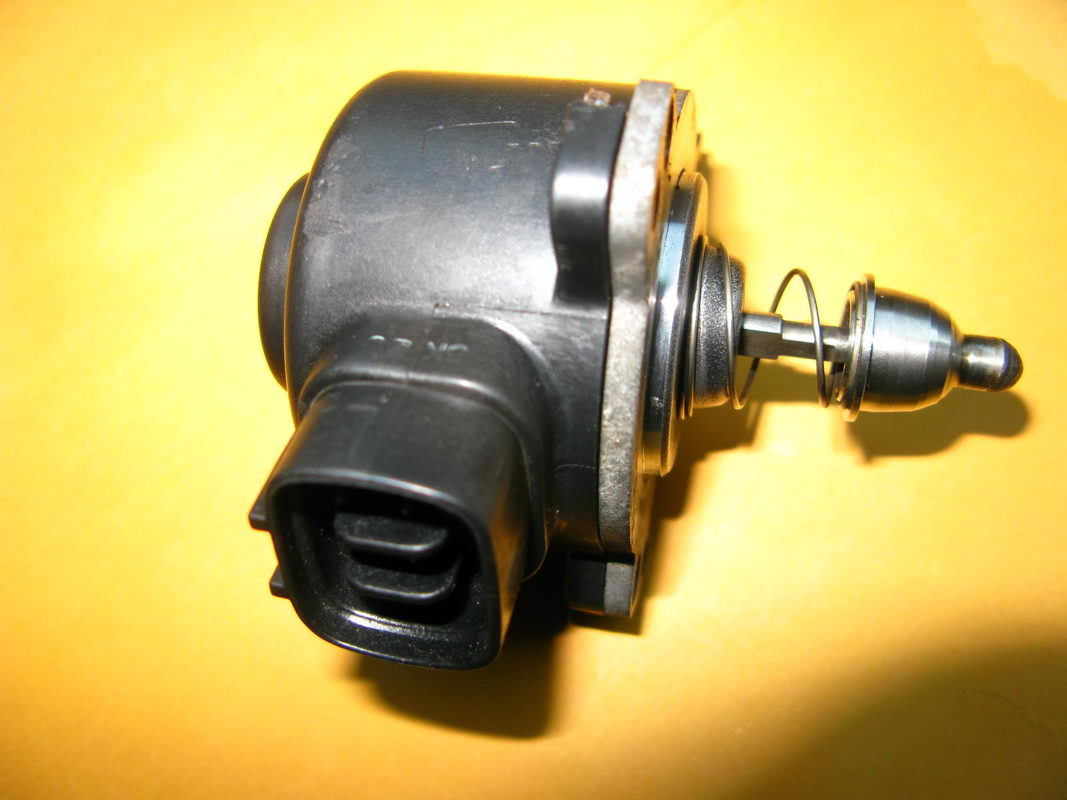
IACV after cleaning.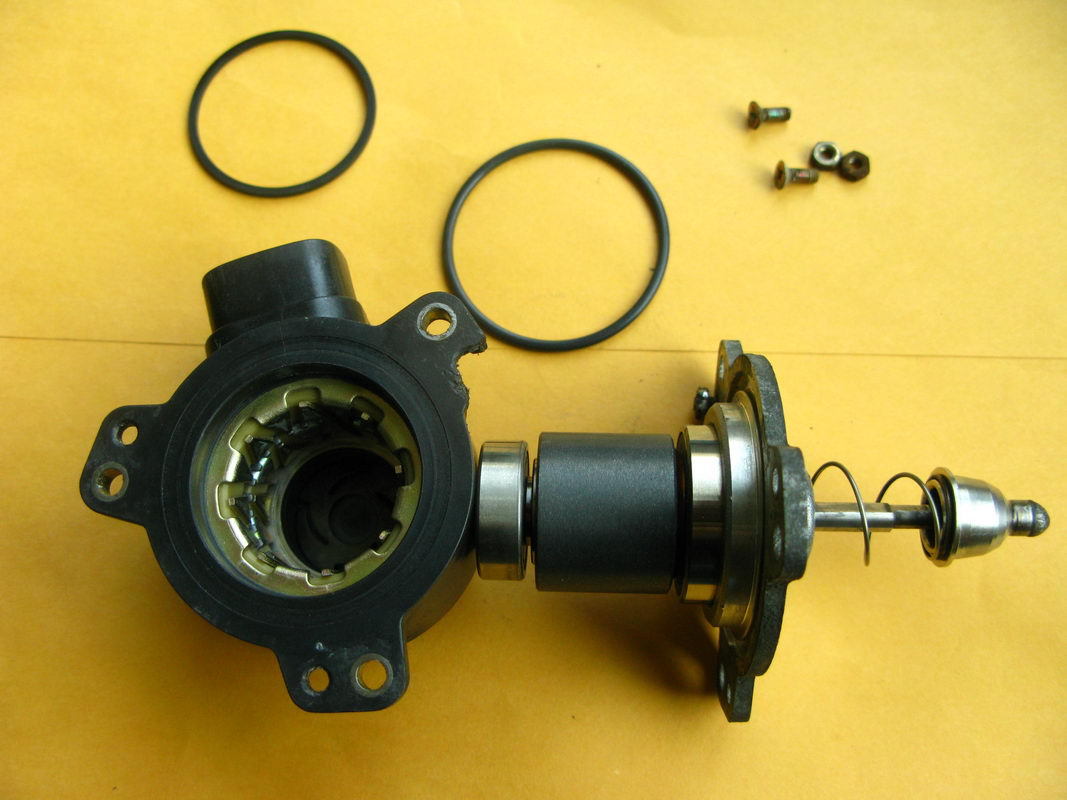
I also inspected the bearings. Here the valve is in closed / extended position.
Here valve is in open (short) position.
Once I assembled the IAC valve, I tested it with 9v battery according to
Lexus instructions. It was slowly moving back and forth in small
increments.
I replaced PCV valve and grommet.
I changed valve cover gaskets and sparkplug seals. Also halfmoon
seals and cam rear bearing cap with its plug. I used old bolts with new
washer for valve cover gasket and for cam bearing caps...
Cam bearing caps, halfmoon plugs, old bolts with new washers.
I also replaced spark plugs and all its wires, triple checking the proper order and placement of wires.
TEMPORARY CONCLUSION:
I realize that all those repairs I did just before the problem appeared point to something I recently did. I still suspect a vacuum leak, but where is it...
Before repairs, the idle was really low, around 350-400 rpms... but there was no fluctuations. Now idle is around 900rpm and fluctuates between 950 and 1300rpm in Park or Neutral. Those fluctuations are very regular (every 1.5 or 2 seconds - I may record it to show you, but didnt get to it yet) and each time when 1300rpm is reached, I can hear an electric buzzing sound, engine shakes a bit to decrease rpm and rpms go down to 950 to repeat... like something wants to lower it back to 950rpm and something else is dragging it up.
In D (drive) it will gradually speed up by itself to 40-45mph without touching gas pedal. When in D on stop light, rpm will sit at around 900.
Maybe I cleaned something too well. By the way, I torqued everything to proper torque with beam torque wrenches or a clicker if beam wrench was too bulky for the particular spot...
I will gradually follow your suggestions. There is so many of them... I have some ideas and doubts.
Thought A. ECU capacitors which may be bad from what I heard must wait a bit. I have no soldering skills yet. I can use digital multimeter a bit... I have to learn more before I attempt that.
Question B. Checking timing with timing light is a bit mysterious to me, but it crossed my mind that timing may be bad, though it seemed fine before. Is there a possibility that timing itself may cause my symptoms?
Question C. Coolant Temperature Sensor -I understand the idea behind it, but wouldn't it cause fluctuations that would be a bit unpredictable, as air bubbles would go through sensor in irregular way, causing computer to fluctuate idle in irregular way? I have very regular fluctuations...
Question D. I installed new distributor caps and rotors, new wires (that were tested for resistance) and new sparkplugs (that were tested for proper gap). What would happen if one rotor was not installed correctly and got damaged... would it cause the car to not turn on at all or would it fluctuate in idle like mine does? I dont think this is it, but I didn't unscrew new distributor caps to inspect new rotors... -
This thread is already solved. I just wanted to thank you for your input and post some pics that are associated with the work I did.
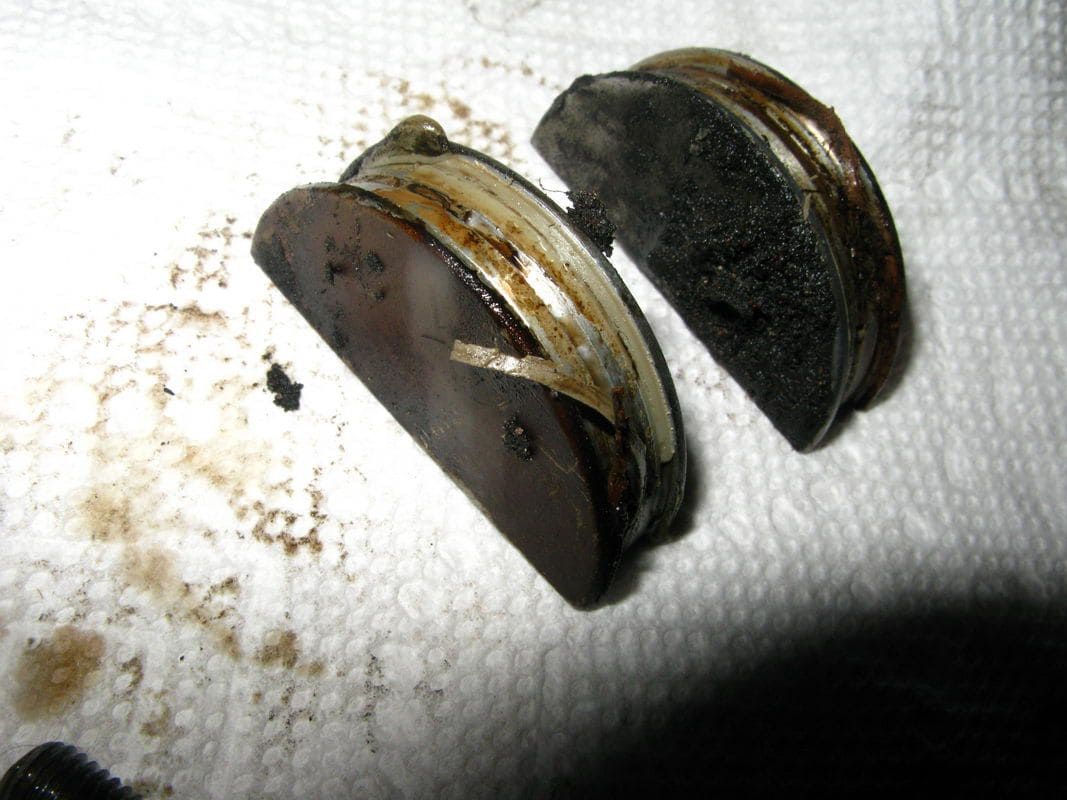
Halfmoon plugs before cleanup
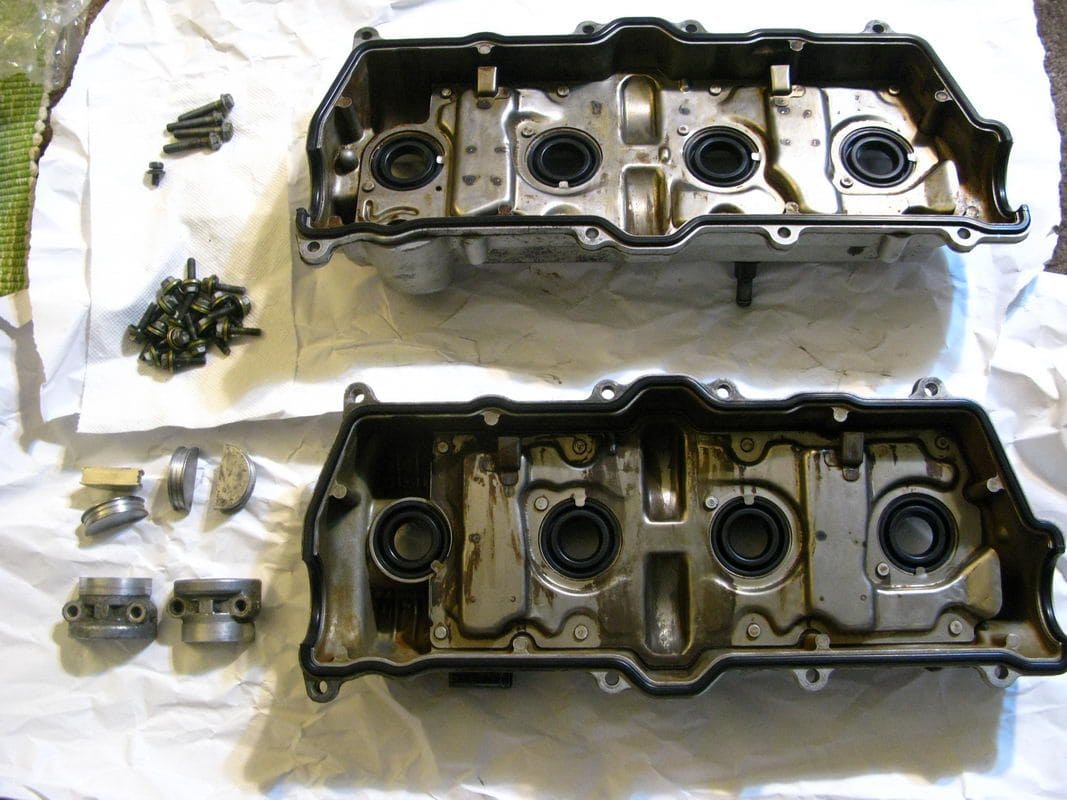
Cleaned valve covers with new spark plug seals and gasket, halfmoon plugs, rear cam bearing caps and valve cover bolts with new washers.

Cleaned halfmoon plugs, rear cam bearing caps and valve cover bolts with new washers.

New sparkplug seals

Installation
of new sparkplug seals (I already installed it and bent the metal tab
back... so this is just a demonstration of my technique)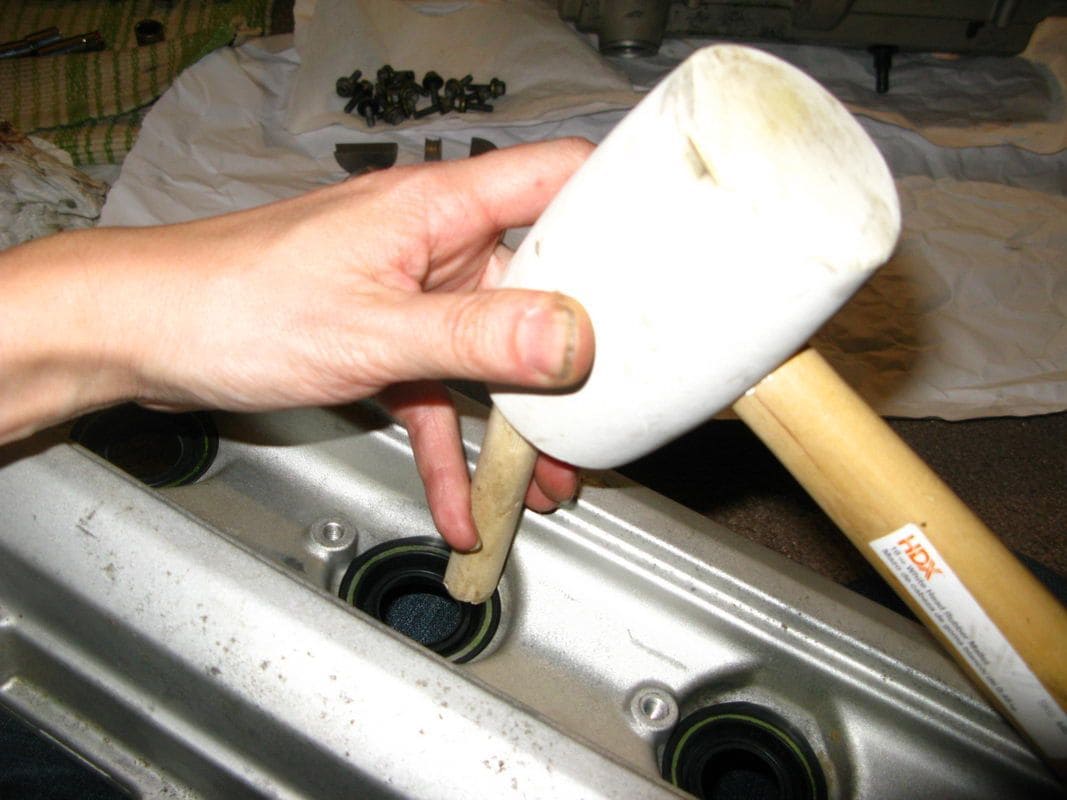
Adjusting
new sparkplug seals so that they sit flush. This is also a way to
remove them (just make sure that the metal tabs on the reverse are bent
out of the way)
Rear plug in the background, ready for installation.
-
Hi,
I didn't do Capacitors... I am not fluent in soldering yet... I didn't inspect ECU. I may do it later/soon.
Fortunately this car is not my daily driver thus I have time to go slowly with next steps, reading about potential problems.
I didn't have the fluctuating idle before the repairs/cleanings I did. Thus I thought it may be a problem with some parts I touched during the repairs rather than the ECU... The list of repairs I did just before the idle problem started is in post number #1.
The reason why I didn't drive the car a lot after my repairs is because I didn't want to do more damage by driving it without learning more about potential causes... I agree with Landar that I probably should drive it and let the computer spit the codes...
Today I drove the car for 10 minutes. It started the fluctuating idle at Park after less than a minute = way before the car got to operating temperature. So I assume it was still in so called OPEN LOOP (?) ... In drive it was keeping stable rpms of approximately 950rpms when stopped and holding foot on the brake. After approximately 5 minutes of driving in my neighborhood it did get to the operating temperature (=CLOSED LOOP?) . I drove the total of 10 minutes. It feels like it is pulling. If I am in drive and don't press on gas pedal or brakes, it will eventually go to 45mph before it stops increasing the speed. Not sure if it's normal. The only way to slow down is to hit on brakes. I don't want to burn my brakes too much. They get hot from driving even for 5 minutes as it requires constant braking...
Next I put the car in Park, let it idle and did test for air leaks with PROPANE TORCH (no flame of course, just propane). I went through the vacuum lines and other potential sources of air leaks... But I didn't observe any change in fluctuating idle pattern. Maybe I should repeat the test.
Once I was done (5 minutes later), I turned the car off and looked underneath the car. I noticed some smoke coming from left and right junction of Catalytic converters with the exhaust pipe located closer to the rear of the car. This smoke/exhaust went through the cat and then some of it out on this junction. Not sure if it is bad. It probably qualifies as exhaust leak. I hope I didn't ruin catalytic converters.
I probably should drive more for the ECU to generate CELs...
-
If I turn the engine on, after overnight rest, it will start doing this only after steadily idling for a minute or two... Once it reaches certain RPM it starts the cycle of high-low idle every 2 seconds... So it looks like it does it only after the engine warms up a bit and only in Park or Neutral.
I wonder what happens every 2-3 seconds. Very regular thing.
-
I just came across Mazda Miata forum http://forum.miata.net/vb/showthread.php?t=388269 and it gave me an idea of unplugging TPS for troubleshooting and see what happens with my idle fluctuating up and down while in Park or Neutral... however I need to read about it more to see if it will not cause any damage in lexus...
-
Sunday Update:
1. AFM Airflow Meter: I inspected it before I started this thread as I took its assembly off of the car when I was doing throttle body cleaning and valve cover gaskets. I did not clean it as I didn't find a protocol for cleaning this type of sensor.
Today I checked resistance on the AFM connector between THA and E2. At the temperature 70F it read 2.36kOhm thus it is within range.
2. Throttle body: I took it off the car and cleaned it before I started this thread. Then I reinstalled it with a new gasket. The TB plate had approximately 1-2mm (1/8 inch) of carbon deposit on the engine air intake chamber side. It was a lot of cleaning. I was careful not to change the positions of TPS... I also checked that the plate are moving when the cables are pulled.
When I put TB back on, I installed new PCV hose and water-by-pass pipe no.4:
- ventilation hose no.2 of PCV system fat hose under the throttle body, part #: 12262-50010 $23 at dealership #
- HOSE for water by-pass pipe no.4 part number: 99556-10050 # rubber hose for cooling water by-pass from right side of throttle body housing
Today I decided to check the condition of throttle position sensor (TPS) by checking the resistance between the terminals using multimeter and 0.4mm and 0.65mm thickness gauges between the throttle stop screw and stop lever. I used the instructions from pdf supplied by Landar (thank you).
Everything is within suggested values:
0.00mm VTA-E2 : 0.55kOhm
0.40mm IDL-E2: 150 Ohm = 0.15kOhm (my additional thickness gauge)
0.50mm IDL-E2: 160 Ohm = 0.16kOhm (my additional thickness gauge)
0.55mm IDL-E2: infinity
0.65mm IDL-E2: infinity
Throttle valve fully open position VTA-E2: 3.5kOhm
VC-E2: 4.9kOhm
Everything is within suggested values thus I didn't unscrew the TPS sensor to adjust its position.
3. Next I will try to see if there is any troubleshooting for EGR. EGR Valve was very dirty and its pipe in air intake chamber was clogged with carbon deposits. I cleaned it before I started this thread.
I may post some pictures later to show you what kind of dirt I encountered here...
-
 1
1



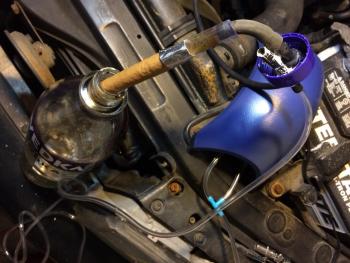
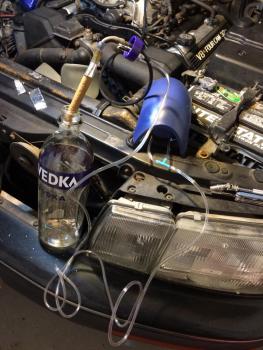
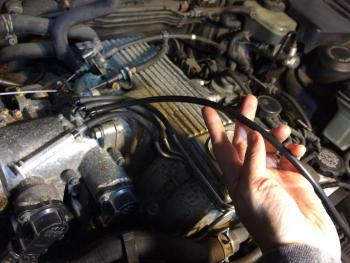
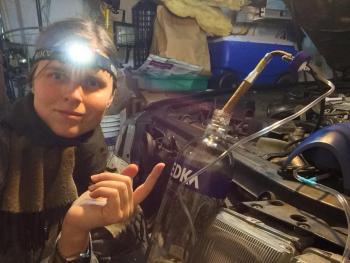

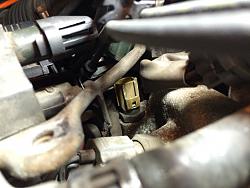
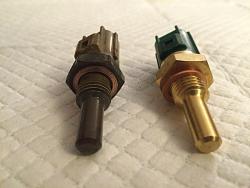
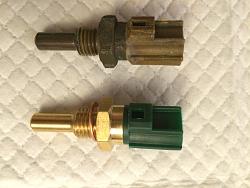
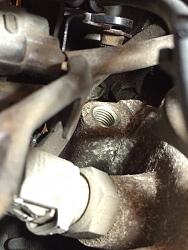
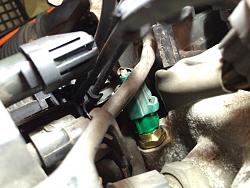

Ls400 Idle Loops Up And Down From 1100rpm To 1600rpm Every 3 Seconds
in 90 - 00 Lexus LS400
Posted
That's an interesting suggestion. If it's true then I don't think it's worth fixing especially given the cost of a dashboard and 300.000+ miles on my LS400 lol
I've been driving my LS400 since I fixed fluctuating idle / haunting idle issue. It runs pretty much fine but that new issue i mentioned in previous post bothers me a bit.
When I start the engine from cold when in P or in D, not driving, idle stays around 700rpm.
But once engine warms up after driving for a few minutes I read around 200rpms in P and in D idling when car is not moving... It worries me a bit. But interesting fact is that so far the car hasn't died yet on its own or stalled even once... I am puzzled.
Another thing is when I cruise at 55 to 60mph I observe only 1200rpm. Is it normal for V8 of LS400? I don't remember how high this number was way before my repairs... V8 is powerful so maybe it's normal...
I am not sure what is the reason for such low idle rpms ... I was thinking that maybe now the "new old" IACV may be stuck closed but it was working in tests with 9v battery so it may as well be working fine... I realize that LS400 1st generation (1990) tend to have a low idle rpms but mine is ultra low.
Does anyone know what is the drawback of such low idle? Is it detrimental to the car or to the fuel economy?
The cool side-effect is that at such low rpms engine is very quiet... Good for meditation ;)
Thanks for any suggestions... Should I make a new thread on this problem? I stayed in this thread given it may be a result of preexisting conditions, besides I already described at length certain repairs and condition of my car...